Summer's End
Tuesday, September 30, 2008
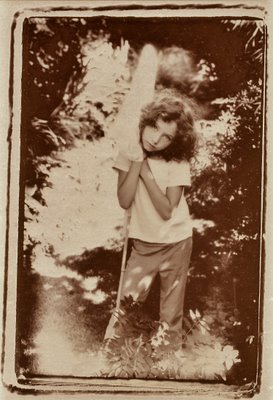
I have written about this before, and, in fact used the very same image of Rebecca to illustrate that garden phenomenon when I look at my hostas with their slug holes and I say, "Slugs it's the end of summer. You can have them."
In two weeks it'll be the longest day in the year... Do you always watch for the longest day of the year and then miss it? I always watch for the longest day in the year and then miss it."
- F. Scott Fitzgerald, The Great Gatsby, Ch. 1
As I started my first fall class at Focal Point the women behind the desk asked me, "How was your summer?" It has been many years (37) since I taught or went to school so this question is particularly meaningless to me and more so since I am a freelancer. I work when I get it and weeks meld into other weeks. Friday and Mondays have no specific image except that traffic is worse when I want to go or leave my studio.
The question however has a romantic memory attached to it for me. It brings me memories from the 1974 film The Great Gatsby with Robert Redford (Jay Gatsby) and Mia Farrow (Daisy Buchanan). Sometime by the end of the film Gatsby, smartly dressed in white and with a white straw hat walks the length of a swimming pool with a male companion (I have forgotten whom). It is a bright sunny day and Gatsby says something like, "It has been a great summer." That one statement in that film is full of meaning and more so when I gaze at this picture or Rebecca.
"I love New York on summer afternoons when everyone's away. There's something very sensuous about it - overripe, as if all sorts of funny fruits were going to fall into your hands."- F. Scott Fitzgerald, The Great Gatsby, Ch. 7
Rebecca almost got hit by a car today as she was cycling to the park. A car was going much too fast and did not notice her. Rebecca should have stopped, but she didn't. There was a sober sort of here-comes-winter-and-soon-I-will-be-an-adult-and-things-will-get-serious look. "I don't want that," she might have been thinking as I concurred.
"He must have felt that he had lost the old warm world, paid a high price for living too long with a single dream. He must have looked up at an unfamiliar sky through frightening leaves and shivered as he found what a grotesque thing a rose is and how raw the sunlight was upon the scarcely created grass. A new world, material without being real, where poor ghosts, breathing dreams like air, drifted fortuitously about...like that ashen, fantastic figure gliding toward him through the amorphous trees."- F. Scott Fitzgerald, The Great Gatsby, Ch. 8
On a less sobering note summer reminds me of Argentine colectivos (buses) and how as a young man I noticed that Argentine men would offer seats to women in the summer but refrain in the winter. It didn't take me long to figure out that in the summer, when Argentine women wear very little clothing, the sight from above as a man stood, was far better during that hot season.
Celebrity, Glamour & The Ordinary Woman
Monday, September 29, 2008

Some years ago Christopher Plummer was in town and my writer friend John Lekich was assigned by the Globe & Mail to interview him. I pressed Lekich to get me on the set so I could snap a portrait of the actor. Getting permission to enter a set has to go through all kinds of protocols and Lekich failed. I was crushed and it did not help when he told me, "Plummer said he would gladly pose for you the next time he comes to town." I was "collecting" portraits of celebrities. I was crushed.
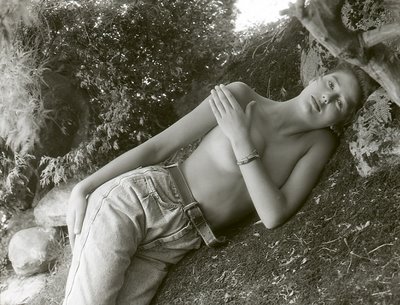
Celebrities of all kinds keep coming to town but fewer great directors and film actors do so with the retreat of the Vancouver Film Festival to whatever vision it is supposed to follow. The celebrities now flock to the Toronto Film Festival, a festival of real consequence. But I am not crushed. I long ago ceased to worry about "capturing" celebrities. Of late I have become most interested in the common man/woman and I revel in taking their pictures. They represent that wonderful and exciting word, potential.
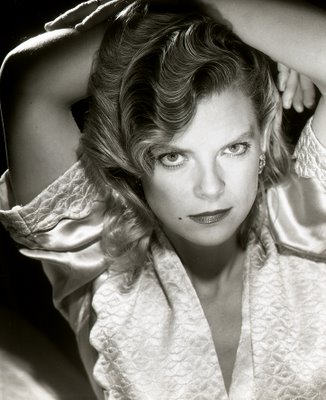
Most of my files are in alphabetical order but I have a few that are not. Witness the photographs of two beautiful women here, Coleen Neill (top, left) and Aaron Ainsley (also in colour). I photographed both at least 20 years ago. They are not filed under their surnames but in a thick file called Glamour. When I photographed them I did not deem them important enough to merit their own files. I am glad I have changed my mind. As of today I will refile them and here they are in all their glory, the beauty of the common woman, the non celebrity, celebrity.
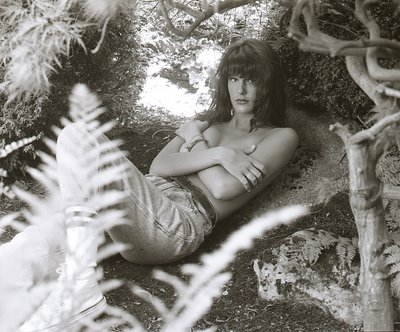
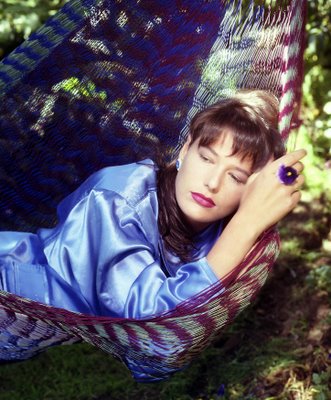
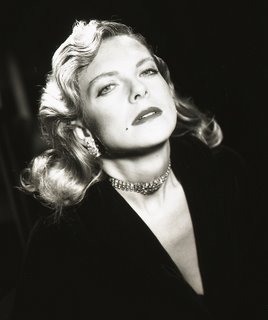
Maestro Bramwell Tovey On Jazz, Elgar & Café Fiorello
Sunday, September 28, 2008
Last night Rosemary, Abraham and I went to the opening season concert of the Vancouver Symphony Orchestra. On the program was:
1. A rousing version (the best I have ever heard) of O Canada.
2. Robert Schumann Cello Concerto in A minor, Op. 129 with soloist Lynn Harrell. Harrell performed an encore of the Sarabande from J.S. Bach's Suite No 5 in A minor for solo cello. Harrell's performance was much mellower and less dramatic than the Pablo Casals version I am accustumed to. But it was sweet, nonetheless and most appropriate after the quiet and also mellow Schumann concerto. Wearing what looked like a black Nehru jacket, I thought that at any moment Harrell was going to levitate and float above the floor in ecstasy.
3. Bramwell Tovey's Urban Runway (commissioned by the NY Philharmonic and the Los Angeles Philharmonic for the 2008 summer season).
4. Sergey Prokofiev's Romeo and Juliet: Suite.
There was an encore of Edward Elgar's Variations on an Original Theme for orchestra, Op. 36 ("Enigma"), with Variation 9 (Adagio) "Nimrod"
My main interest that evening was the Prokofiev as I have seen the Romeo and Juliet ballet performed twice by Evelyn Hart. As I listened to the music I could imagine her dancing in my imagination. It was beautifully played and I especially liked the sound of the cornet that represented Juliet.
But the evening was special for two other reasons. Tovey's Urban Runway to my untrained ears with its jazz sounds (played by what seemed to be a reinforced orchestra) sounded like Gershwin on speed! It was lively, exciting and wonderfully loud at times. No matter how often I listen to Elgar's Nimrod I will never tire of it. It may just be that some years ago as I traveled in a fast train between Crewe and Euston Station in London I saw the miniature landscapes (with miniature clouds hovering over the miniature hills) of the English countryside and I could imagine Elgar's music. The landscape was Elgar. Bramwell Tovey brings with his interest in jazz and love for Elgar a warm sociability to his role as Maestro of our city symphony orchestra. A couple of months ago I had a chance to take his photograph in my studio and we chatted.
I asked him how he came to learn to play the jazz piano. He told me:
I learned to play the jazz piano by ear in church when I was a boy in Ilford near London. I learned the classical piano as well. When I came to North America I tried to jam with jazz musicians. I got into it and I listened to a lot of jazz. I like the act of improvisation because I spend nearly all day, every day with my head in a score. When I play jazz I have the score in my head so it is like a reversal of roles. I am not conducting the music that is all written down. I become the individual who is performing and I can create in my heart at the same time. I find improvisation liberating and I am glad I can do both. (jazz piano and classical piano)
I asked Tovey who his favourite English composer was.
It is Edward Elgar and not because of the pomp and circumstance side of his music which is entertaining these days with the world of imperialism that has fallen away but simply because of the introspection of some of his music. His Engigma Variations and his First Symphony are about an intense personal journey that he underwent from being the son of a piano tuner to being a friend of Kind Edward VII. When he underwent that journey, England was a class driven society, it still is, and he drove through all those barriers with his extraordinary personal talent. He is the most gifted instrumental composer that England has produced.
For anybody who reads the NY Times regularly (me!) it would be quickly known that Tovey is beloved by the audience when he directs the NY Philharmonic in the summer festivals there. He is not only valued for his conducting but for his intimate chatter on all things musical (or not). So I asked Tovey if he was an adopted son of New York.
I may be an adopted son of New York but I am Canadian now. I am married to a Canadian. I have Canadian children. I regard myself as an adopted Canadian. But in New York, I love the city! I have been going regularly since 2000. I do this summer festival. Opposite Lincoln Center there is this Italian restaurant called Café Fiorello. It has the greatest antipasto bar of any Italian restaurant that I have ever been in. I live in that restaurant. I meet people there for casual coffee, for breakfast for dessert. I find that the whole of New York seems to come through that restaurant. When I arrive at Fiorello's and I have had profiteroles then I feel like a real New Yorker.
Saturday night's concert will be repeated tomorrow, Monday September 29
Christopher Gaze - From Richard III To King Lear & Back
Saturday, September 27, 2008
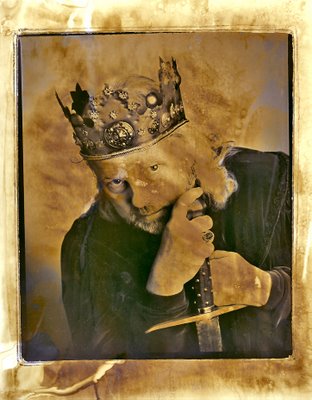
Last night Rosemary, Abraham Rogatnick and I went to the last performance of Bard on the Beach's production of William Shakespeare's King Lear with Christopher Gaze as Lear. Of Christopher Gaze as Lear I first wrote here.
As I prepared today and looked for the images I was going to use for this blog I was troubled with a melancholy that came to me for several reasons. As I look out the window our garden is decaying and the hosta leaves no longer look pristine in their greeness, blueness or goldness. Yellow is beginning to creep in on them all. The buds of some of my roses will not open and I think of them as potential beauty cut short by the season in much the way as that of a young woman or man cut short in the prime of life. Certainly it is the stuff to precipitate melancholy.
But there is a more important reason for it all. Somehow in all of my 66 years I never attended a performance of King Lear. Nor would I have ever suspected that I would do so with a loving friend who is of the same age as the Shakespearian King Lear. Not only that but Abraham Rogatnick (86) knows most of the lines of the play by heart. I watched him smile at Christopher Gaze's exquisite performance (on a wheel chair). With his usually neat hair combed, askew in every direction, I was watching the decay of time made worse by Rogatnick's confirmation of Gaze's accurate inerpretation. Watching Gaze lapse into insanity and ramble on I could see elements within myself. Will I become the role model of old age that Rogatnick embodies for me or will I become the foolish man of Shakespeare's play?
It didn't take me long to understand that the tragedy of the play hinges on a young woman's reticence to openly declare her love for her father. My mother died without me ever telling her so. Was my mother more prescient in understanding my reluctance to be vocal? My father and I understood our mutual love for each other without words. I believe he knew of it when he died. Yet my mother often told me, "Love, Alex is not saying but doing."
After both of King Lear's older daughters, Goneril and Regan, vocalize their love for their father upon his request, Lear says to his favourite, Cordelia:
...what can you say, to draw a third more opulent than your sisters? Speak.
Cordelia: Nothing my lord.
Lear: Nothing?
Cordelia: Nothing.
Lear: Nothing will come of nothing: speak again.
Cordelia: Unhappy that I am, I cannot heave my heart into my mouth: I love your majesty according to my bond; no more no less.
Lear: How, how Cordelia! mend your speach a little lest you may mar your fortunes.
Cordelia: Good my lord, You have begot me, bred me, lov'd me: I return those duties back as are right fit, obey you, and most honour you. Why have my sisters husbands, if they say they love you all? Haply, when I shall wed, that lord whose hand must take my plight, shall carry half my love whith him, half my care and duty: sure I shall never marry like my sisters, to love my father all.
Lear: But goes thy heart with this?
Cordelia: Aye, my good lord.
Lear: So young and so untender?
Cordelia: So young, my lord and true.
The tragedy then unfolds because of this misunderstanding. It would seem that Lear and my mother were at odds. Love sometimes is saying and not doing. Cordelia is banished and disinherited.
Watching Lear destroy his family (did he destroy his once mentioned dead wife? Of this we do not know), I felt a fear as my daughters become older and my eldest granddaughter begins to declare her independence not only from her immediate family but from me. I long for a little phone call, "Hi, papi, this is Rebecca. How are you?" Yes, love, sometimes is saying.
I have written here before on how I had the opportunity to photograph Chistopher Gaze as Richard III in 1984 and again in 1998. It seems appropriate that I first met Gaze when he was a much younger man playing in one of Shakespeare's earlier plays. It further seems appropriate that King Lear may be Gaze's last big part in a Shakespeare play written quite a few years later when Shakespeare's own father had died. As I lisened to Gaze give his company a sweet but melancholy speech backstage last night I kept thinking on how all those elements of my own personal life which had begun coincidentally in 1955 when I lived with my mother and grandmother on Calle Shakespeare in Mexico City had perhaps randomly conspired that I was to see Lear only last night and not before.
The image here of Christopher Gaze as Richard III, which I took in 1998, is a faded b+w photograph that has deteriorated so wonderfully (badly fixed!). It is a photograph that compresses not only Gaze's journey from Richard III to King Lear but also reminds me how much pleasure (and occasional melancholy) Christopher Gaze and his Bard on the Beach have brought to my Most special of all was being able to see King Lear through the eyes and ears of Abraham Rogatnick.
Thinking Inside Of The Box - The Old & The New
Friday, September 26, 2008
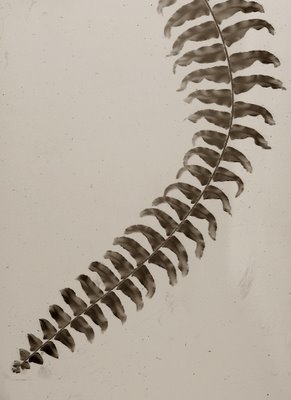
I have written here before how my approach to photography is an awareness and a concern with three dimensions. Today I teach my third class (out of 10) History of Photography at VANarts. Instead of hearing me in a long three hour lecture I am throwing them into a studio with the idea that they must immerse themselves in the early 19th century of photography. For a week I have been thinking about it and trying to see what 17 students with high-end digital cameras can do. Since some are beginners they still don't know the ins and outs of their equipment.
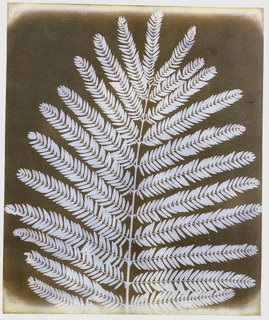
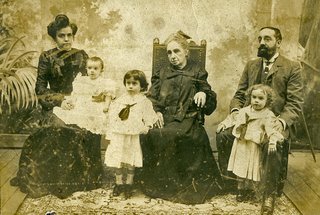
In this blog I have thrown in a mixture of really old family photographs (my family) taken in the 1880s with some old photographs of that century plus some fresh "old" pictures that I fixed up last night as I wrote this. Most of the solutions involved include putting hard copy (photographs on paper) on to my scanner or modifying with colour shifts such as Photoshop sepia toning of regular b+w photographs.
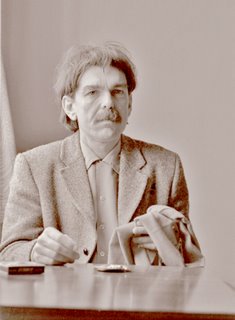
But how to do this with a digital camera? Much has been written and said about thinking outside of the box. In this case my students, for some of the tricks, will have to think within the box that is their camera. They will take pictures in a studio without artificial lights. Perhaps they will place their cameras on tripods and try to use very long exposures so that their subjects will stiphen in an effort of not moving.

I believe that the ultimate palette is limited if all one can do is to work within that photographic box.
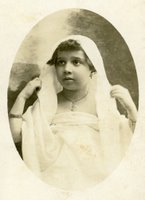
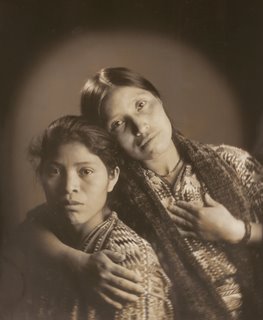
After much thought I have found a solution which I will try to impart to my class. Many of my photographs with only small tweaks look like old photographs. Why is this? It has to do with the posing of my subjects. It is important what I ask them to do with their hands and how they stand or sit. The lighting can be modern but the rest borrows from the posing of the 19th century. I will see if this solution is indeed a solution today.
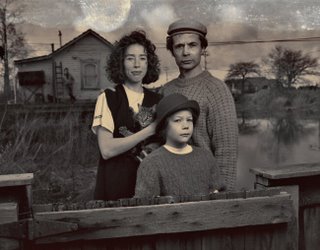
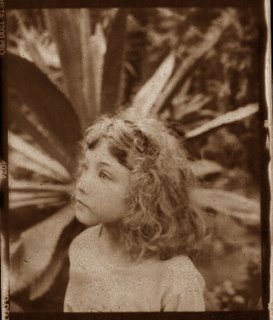
Image: Scanned fern, upper left, Alex W-H September 25 2008
Image: My ancestors, Barcelona 1888
Top Right: Botanical specimen, photogenic drawing negative 1839 Henry Fox Talbot
Below left, Captain Beefheart, Alex W-H Vancouver 1982
Below (oval) My mother 1919
Right in b+w: Annie My First Success, January 1865 Julia Margaret Cameron
Guatemalan weavers, María and Dominga, Vancouver, Alex W-H 2002
Below left: Finn Slough, Richmond, Alex W-H 1997
Rebecca and agave, Queen Elizaabeth Park, Alex W-H 2004
Murray Pezim, Mr. Poland & No Light Bulb
Thursday, September 25, 2008
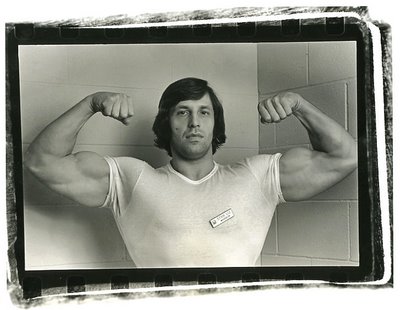
When Murray Pezim (below) died on November 11, 1998 The CBC said in its obituary:
Colourful Vancouver stock promoter Murray Pezim died of a heart attack early Wednesday morning. He was 77 and has been ill for a number of months.
Pezim was once considered the most powerful man on the Vancouver Stock Exchange. At one point his companies were involved in a about a quarter of all trades.
His two biggest gold discoveries were Hemlo in northern Ontario and Eskay Creek in northwestern British Columbia. He was also a former owner of the B.C. Lions football team.
Pezim suffered a heart attack late Tuesday night, and died early Wednesday morning in a Vancouver hospital.
Through much of the 70s and 80s I had the opportunity to photograph this man in many locations and under many circumstances for Vancouver Magazine and many business magazines. When he died the Vancouver Stock Exchange was in its last legs having lost all of its credibility around the world. David Baines of the Vancouver Sun and Adrian du Plessis, a free-lance white collar crime investigator, had put the final nails on the coffin. With the death of Pezim the stock exchange lost all the humor and flamboyance he had contributed to it.
But there are two occasions related to Murray Pezim I will never forget. It has to do with the photograph I almost took and the one I didn't.
In the early 80s Pezim used any ploy to get press space. He sent a press release to Vancouver Magazine that he had hired the former Mr. Poland, Stan Liz to be his personal masseur. Mac Parry dispatched writer Les Wiseman and I to interview and photograph Liz. I told Wiseman that I knew exactly what I was going to do. I was going to ask the man to stand on a chair and hold on to an overhead light bulb. It was going to be a Polish joke. When we got there Liz could barely communicate in English and I realized I would not have any problem carrying out my idea.
Some years later Equity art director Chris Dahl paged me. I found a phone and talked to him. "Alex I want you to photograph The Pez (as Pezim was affectionately known) holding a hanging knot on himself. The story is all about how he has become his worst enemy." I immediately responded, "Sorry Chris I can't. I was a Boy Scout and the one knot I was never allowed to tie was a hanging noose. I will not have any part of this." Not only did I lose the job but I then found out that it had been a cover assignment so I missed out on a good piece of change.
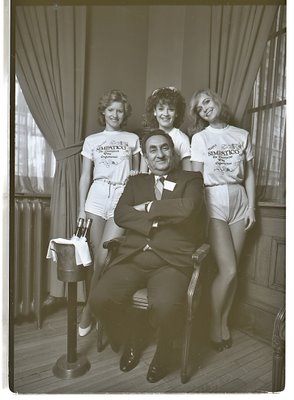
In later years particularly in such publications as Business in Vancouver and the Vancouver Courier there was a run of photographs much like the ones I almost took. I always flinched in embarrassment when I saw them. I felt sorry for the subjects and had little respect for the photographers who showed so little consideration for the human dignity we are all born with.
Perhaps I had indeed learned something while being a Boy Scout.
Addendum:
I dispatched links to this blog to both David Baines and Adrian du Plessis inquiring on my accuracy. Here is one reply:
Dear Alex ~
I believe David is off somewhere, rumour has it, he's spending the reserves in his Cayman accounts. When he checks in, he may have a different view, but, it all looks good to me!
You could describe me as eligible bachelor, music-lover, friend to felines, and other such titles, but, in the context of your blog post, I can't say that the words you've chosen don't fit the bill.
Those WERE the good ol' days in the stock trade. I wonder who's still got a Pez dispenser from Murray...
Sláinte, Adrian
Adrian du Plessis
Allison Crowe Music
(250) 537-1286 www.allisoncrowe.com
"Why music?" "Why breathing?"
And David Baines (Back from the Caymans?) wrote:
Hi Alex:
Your piece brings back warm memories.
When Pezim was on his death bed, I wrote this column (appended). Even though it was a sad occasion, it is one of my favorite recollections of The Pez.
David
Pezim down but certainly not out
The Vancouver Sun
Friday, April 18, 1997
Page: D1 / FRONT
Section: Business
Byline: David Baines, Sun Business Reporter
Source: Vancouver Sun
Tony, the doorman at the Hyatt Regency Hotel, beamed at the mention of his name.
``I know Murray Pezim very well. He's a really neat guy. A real gentleman. He was always very nice to us,'' he said.
Tony says he was one of the first to invest in Pezim's biggest gold find, International Corona Resources, which discovered the Hemlo gold fields. He bought his shares at a buck, and before long, they went to the moon.
Not all Pezim's investors fared so well. I remembered when two young comedians, who were trying to market a board game called Punchlines, visited me at my office and described their experience with Pezim.
One, pretending to be Pezim, draped his right arm over the other and told him how he was going to finance his deal and make him rich. As he was talking, he slipped his right hand into his partner's jacket pocket and quietly relieved him of his wallet.
They laughed at their little skit. Pezim had taken them on a ride to nowhere, but what fun they had had.
Back at the Hyatt, a car pulled up and jazz singer Kenny Colman, a long-time friend and fan of the Pez, waved from the passenger seat. His partner of five years, Lilly Krief, was driving. Tony opened the back door for me and I jumped in. We were going to Murray's world.
``Murray's a throwback, the last of Damon Runyan characters,'' said Colman. ``He's a real Guys and Dolls character. If he wanted, he could have been a movie impresario, like Louis B. Mayer.
``He liked me around because he wanted to meet celebrities. I remember one night when we were at the Desert Inn in Vegas. He told me he wanted to meet Frank Sinatra, so we went back stage and, well -- you know Murray -- I was little nervous about what he would say.''
But Pezim stepped right up to the man they call the Chairman of the Board and said, ``Frank, if I'd met you 25 years ago, I'd have named a gold mine after you.'' In a single brilliant stroke, Pezim had not only made Sinatra feel like gold, he had indelibly impressed himself as the man could actually produce gold. He would not need a second introduction.
``That was Murray,'' said Colman. ``Always promoting. It was never the money, it was always the action. When Murray's not in the action, he's dying.''
The word hung for a split second, then Colman resumed his patter. ``Here's a copy of my CD,'' he said, handing me a plastic-wrapped disc entitled Dreamscape.
``You don't have to mention my name, but if you do, there's no `e' in Colman. And if you don't, please mention the club,'' he said, referring to his jazz club, the Casbah Jazzbah on West Pender.
We were getting close to Murray's world, once riotously populated with movers and shakers and hangers-on.
``There were always these struggling people around him,'' said Colman. ``But they never scored off him. You could never fool him, unless you were some blonde in an elevator.''
Lilly drove the car to Rooster's Quarters on Denman, where she picked some Montreal-style chicken. Then we drove to Pezim's high-rise condo at the foot of Hornby Street, overlooking False Creek.
As we were getting out of the car, Colman warned me Murray's world had changed. ``He wanted to cancel. He said he didn't feel up to it, but I told him he needs to see people.''
A Filipino caregiver answered the door on the 22nd floor. It opened to a fabulous view of False Creek. The furnishings were symmetrically stylish. Very un-Pez like.
The greatest promoter in Canadian stock market history, now 75, was in his bedroom lying on his side. ``David, how are you?'' he smiled. Fine, I said, but how was he?
``I'm a strong son of a bitch. I should have been dead by now,'' he replied.
He dressed. The caregiver helped him into his wheelchair and pushed him to a glass table overlooking the south shore. The sky generously allowed some sun into the room. Lilly, a most gracious woman, fussed with the food. Pezim's left arm lay idle, a casualty of last year's stroke.
``I'm embarrassed that this could have happened to me,'' he said.
``Murray,'' chimed in Colman, ``do you remember when you owned the B.C. Lions and we had Pez Day? When was the last time 40,000 people went to a football game in this town? I sang O Canada that day.''
``That was the worst part it,'' Pezim said, deadpan.
I remembered that day. Pezim's girlfriend, the stunning Tammy Patrick, who he had rescued from a serious cocaine addiction, wore a Lions jersey with No. 4 on it, signifying she was to become his fourth wife. (It didn't happen).
Pezim had also agreed to manage the nascent boxing career of Mark Gastineau, the former NFL football star. (That didn't happen either). Gastineau and actress Brigitte Nielsen temporarily moved in with Murray. Doug Flutie visited Vancouver and woke up in the morning with a hangover from laughing so hard, and a new contract to play with a team he had barely heard of.
Sports Illustrated writer Doug Looney flew to Vancouver to write a story about Flutie, but instead did a hilarious story about The Pez.
Looney followed Pezim to his second home in Scottsdale, Ariz., where he met his maid, ``who looks like no maid you have ever seen before,'' then to his $5.5-million house in Vancouver where he was introduced to Pearl the gardener, ``who looks like no gardener you've ever seen.''
The story was 10 pages in length, an honor the magazine has never bestowed upon any local athlete. ``It's great for the CFL,'' remarked Pezim. ``They tell me they have 79 million f------ readers.''
Robin Leach, the nasal host of Lives of the Rich and Famous, also flew to Vancouver to do a piece on Pezim. The background music was the theme song from Goldfinger.
Pezim reflected on those days. He said the Hemlo discovery was the best time in his career. Then there was Eskay Creek in northern B.C., another big gold find. He created big, rolling markets for his stocks. There was lots of action for everybody.
``David, I've lived a full life. I've done everything I want. I can't say God has been bad to me, but I can yell at him sometimes.''
He says he would prefer to be in the warm climate of Scottsdale, Ariz., his second home, but the medical bills were prohibitive.
``I'll bet in the last three years it has cost me $500,000.''
He says he wants to rally, at least long enough to make a public appearance. ``I really would like to walk down Howe Street. I feel I'm about eight to 12 weeks away.''
He scoffs at the blue-chip pretension that has swept the Street. Speculation has been gussied up and is now assuming the guise of investment.
``It's a totally speculative market,'' he insists. ``The problem is, it's being sold for something different.''
Bre-X Minerals, he says, happened because ``some Eastern guys took over this junior market and added a couple of zeros to it.''
Asked about his son, Dr. Michael Pezim, who took control of his flagship company, Prime Equities International, he said, ``His view of how to run the company is different from mine, but he can have his opinion.''
He once spent his days scanning a battery of quote terminals, but there is not a single machine in his apartment. ``The market is behind me now, but I do miss it. If I had the right ingredient. . . .''
Colman starts singing the words to the old Duke Ellington song, Satin Doll: ``Cigarette holder, which wigs me. . . .''
Pezim joins in: ``Over her shoulder, she digs me. Out cattin', my satin doll.''
They laugh. Forty-five minutes has passed. Pezim says he doesn't feel well. His head, he says, is spinning.
We shake hands. He tells me to watch out for Golden Trump Resources, a Prime company that has acquired some gold prospects in Mexico.
``It could be a screamer,'' he says.
We say good-bye to Murray, and to Murray's world.
Out in the hallway, we wait for the elevator. For some inexplicable reason, we are beaming. Just like Tony.
Graham Clarke, Peter Ladner, The MV Britannia & An Arca Swiss Head
Wednesday, September 24, 2008

Monday at City Hall I was introduced to a tall handsome man who smiled with his eyes. He looked familiar. He commented on my Arca Swiss ball tripod head (it cost me $600 some 20 years ago!). "I have one of those and I mount my Canon DSLR on it," he told me.
Sometime in early 1989 Peter Ladner called me up and came to my house. He wanted me to take the initial photographs for his new magazine venture called Business in Vancouver. This lasted for 6 months until they decided they could no longer afford my rates. The tabloid size paper was going to be a weekly and the original design was by designer Rick Staehling. Staehling stipulated colour pictures on the cover. Once the paper was established, art director Randy Pearsall was to take over. Since this was the pre-digital age in some cases I shot with what then was ultimate cutting edge technology, Polaroid Instant Colour Slide film. I had a manual processor and after taking the pictures I would process them on the spot and run to BIV (as Business in Vancouver came to be known). When the assignments had more lead time I used medium format transparency Ektachrome film.
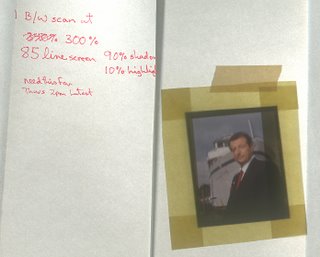
The tall man City Hall said he was Graham Clarke. He told me he was the CEO of the Vancouver Airport Authority. He then told me (his memory being better than mine) you have taken my picture."
This morning I investigated and found Ektachromes of Graham Clarke next to a vessel called the Britannia. I then remembered that sometime in the late 80s he was involved with a company called Harbour Ferries now called Harbour Cruises. The files were marked Business in Vancouver under his name. The vessel is the MV Britannia.
I called BIV today and found that Randy Pearsall, is still the art director and still has a full head of red hair. But he confessed to me, "I no longer drive strange French cars." I remember him driving a shocking lime green Renault Le Car! I asked him about Graham Clarke. "Alex I just happen to have some early copies of BIV here and here he is, October 2, 1989."
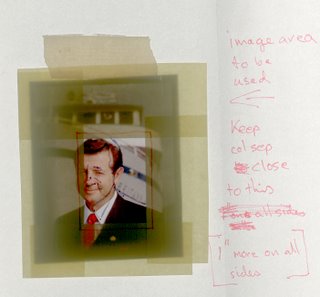
In my files I found two neatly handwritten instructions(by Randy Pearsall) with two masked transparencies of Clarke. In pre digital age transparencies were not scanned but went through a process called colour separation. Here they are. And below a scan of my useful and somewhat used Arca Swiss tripod head that started all this.
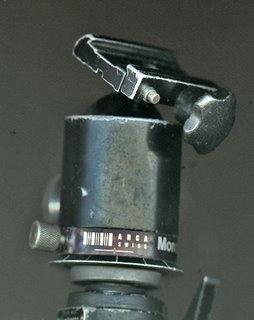 Addendum:
Addendum: name: Randy
comments: I don't want to take up your time on the phone again, but
you mentioned I still have a full head of red hair. Sorry to
say it's only red on the edges leading to grey and then very
thin on top.
Take care Alex
Civics & Civility At City Hall With Sam Sullivan
Tuesday, September 23, 2008
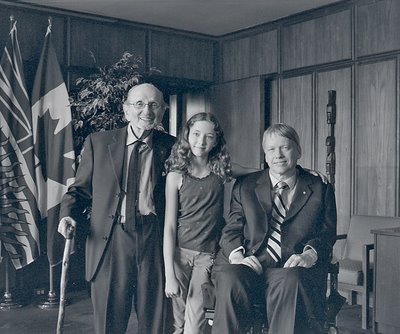
I consider myself to be lucky to be Sam Sullivan's , friend. A couple of years ago he came to an opening of a show of mine and I introduced him to my granddaughter Rebecca. "Rebecca this is the big cheese in Vancouver." Sullivan retorted, "People do what I tell them to do and if I ask your grandfather to do 50 pushups right now, he will." Rebecca was impressed but her opinion and my opinion of our mayor was clouded by differing ones from some of her other relatives. It was at that first meeting with Rebecca that Sullivan mentioned to her face that she reminded him of a Boticelli portrait.
With Sam Sullivan's waning days as mayor I had the idea that going to city hall with Rebecca and our friend Abraham Rogatnick (a friend and unofficial advisor to Sullivan) and visit him at his office would offer Rebecca and excellent lesson in civics.
When I was 16 I had one teacher at St. Edward's High School (a Roman Catholic boarding school in Austin, Texas) who was not a Brother of the Holy Cross. He was our baseball coach and his name was Forrest Wright. He had flaming red hair and we had a great respect for him. Part of this respect came from seeing his face match the colour of his hair when he got angry. Not that he ever did. We just knew. Besides teaching us English he taught us civics. I remember him explaining the difference between a felony and a misdemeanor and going into great detail on the difference between first degree murder and second degree murder. I learned a lot in his class. I felt in the last few weeks that Rebecca was perhaps ready for a jolt of civics. I should have known better and taken myself as an example.
When I was 15 our freshman class took to a trip (in a rented Greyhound Scenicruiser) to Washington DC. We visited the Capitol and had a chat with our Texas senator. The large man with very big ears shook each of our hands and gave us advice on being good citizens. He gave us each a card, signed by him, that certified we had been present at a US Senate proceeding. The moment I was outside I chucked the card, signed by Lyndon B. Johnson into the pavement. That's what I though of politics. They were a bore. Being four years older than Rebecca I should have thought twice about my idea of going to city hall.
In the time that Sam Sullivan has been mayor, while being my friend, I have never lobbied for any favours or special privileges. Except for this time when I emailed Anna Luccarino, the mayor's assistant requesting an audience with the mayor. The response to my request was quick and we were given an appointment for yesterday at 3:30.
Besides our audience with Sullivan, Rogatnick was going to give Rebecca a quick tour and explanation of Art Deco. I mentioned to Rebecca the beautiful elevators that would take us to the mayor's office.
Outside the mayor's office we met up with Rogatnick. "Abraham," said Rebecca, "You and Obama have something in common." "What's that asked Rogatnick?" "Both of you went to Harvard, "explained Rebecca. "There is a difference between us"," insisted Rogatnick. "What's that?" Rebecca asked. "He has one degree from Harvard and I have two."
We were ushered into Sullivan's office and the mayor was warm and friendly. I took my photograph of the three with window lighting with my camera on a tripod. The office had changed since the last time I had been there. There was no more desk. Vancouver mayors in the past have sat behind this imposing desk at the end of the room. In small sort of like having an audience with Benito Mussolini. Sullivan did away with the desk and placed a long table instead. We sat down and Rogatnick removed a pile of books on Art Deco from a plastic bag. "I went to the library to find these." By that point Rebecca was using body language to reflect her boredom. There was a lot of open-mouth yawning. Rogatnick explained the Art Deco obsession with sky scrapers and the Empire State Building. He told us that City Hall looks exactly like a truncated Empire State Building. This I was able to confirm when we left and looked back on City Hall from 12th Avenue. He told us of the symbolism of rising suns, steam ships, airplanes and dirigibles.
Rebecca wanted to see the clothing of the period. We found out that the exquisite shoes of the Art Deco age where a result of the paving of streets the advent of cars. There was no more mud. There were no more horse droppings to soil people's feet. That is why they had worn ankle boots. The short skirts were a protest to the long dresses (you must not gaze on my ankles!) of the Victorian age. At this point Rebecca said, "And they strapped their breasts so they would look flat chested." And then she added, "I don't wear dresses. My friends don't wear dresses. My mom does sometimes." Rogatnick tried again. "This is a cloche hat. Women in the 20s wore them. Cloche means bell in French." She yawned.
While this was going on Sullivan was looking in my direction. He seemed to understand my comment, "Abraham we are going through temporary dark ages. We will have a Renaissance some time soon." Abraham countered with, "I love to teach but I expect my students to pay attention."
Sulliven offered Rebecca a moon cake. When Rebecca saw that the packaging was Chinese she said, "It is probably poison." I whispered in her ear, "Take it anyway and then you can throw it away at home." I added, out loud, "Perhaps your mother who loves sweets will eat them." Rebecca firmly and loudly said, "She won't." Sullivan then suggested (in jest), "Rebecca offer them to your friends and watch them. If they survive then it's all right for you to eat them." By this point I wanted to hide under the table. Sullivan whispered in his inimicable way, "One day you will impress people with your knowledge of Art Deco."
From the mayor's office Sullivan took us to the Council Chambers. It was locked and dark. Sullivan had it opened and the lights were turned on. He instructed the attendant to ring the bell under the doorway. Rogatnick pointed out the Art Deco ornaments on the doors and around the room. Sullivan explained to Rebecca how democracy worked in the room and how decisions were made. Rebecca yawned.
We managed to leave with some sort of decorum while I thought that the lesson to be learned came mostly from our Mayor. Civics is important but civility perhaps more. And Mayor Sam Sullivan has it in spades. I will never forget that and his kindness towards Rebecca.
Perhaps not. "Do you understand that Abraham went to the library to get all those heavy books for you?" I told Rebecca on the bus home. "They weren't that heavy," she answered back.
And Abraham Rogatnick? "I don't know why I am laughing. This is serious," he said over the phone when we talked this morning. But Rebecca did learn something". At the dinner table she said, "I know what a cloche hat is."
And Sam, I appreciate what you did and I am sure that someday, Rebecca who was born, in this your city and her city, will come to understand and will be perfectly thrilled that you gave her that opportunity to get a glimpse of civics and civility.
A Bowl Of Roses
Monday, September 22, 2008

Sunday when I went into the garden before my granddaughters arrived (and later in the day their mother Hilary would show up for dinner) I went to see which roses I could cut to display on the dinner table. Even though it was a day before autumn there were many roses in bloom. But most were from roses that tended to cluster in threes. When this happens the middle rose is in bloom while on each side they are yet to open. If you cut these below the three you prevent the opening of the other two. The only solution is a bowl of roses. When you cut that middle rose the stem is no longer than an inch and a half and that is too short for a vase. So what one does is fill a shallow bowl with water and float the roses after cutting that stem to about an inch. My mother's Mexican bowl looked beautiful with the roses which were mostly from English Roses, St. Swithun and Spirit of Freedom.

There are a few others like Abraham Darby, Shropshire Lad, Mary Rose and Fair Bianca. That small red bud in the green vase is an old climber that came with our house, Rosa 'Blaze'. Somehow this infrequent re-bloomer bloomed. I placed the bowl and the vase on our new dining room table tablecloth. I purchased it a couple of weeks ago on Granville Island. It is from India.
Lauren was keen to have her picture taken in her sailor dress but Rebecca did not want to wear a dress. Both, in my eyes, look lovely.
Sunday, September 21, 2008

Today Sunday was a Saturday for us because we had Rebecca and Lauren over. They no longer come on Saturdays. The occasional Sunday will have to do.
After Rebecca's noon piano lesson (we recently had that Chickering tuned) we had a home made pizza and we then went to see Josh Martin (left) and the 605 Collective at the Roundhouse presented by Dance Allsorts. While there were two performances today the early one at two was free for children under 12. Rosemary's response to the challenging (physically challenging, too) blend of hip hop, modern dance, karate (yes!) and other sports into dance was ambivalent. But she did admit that Josh Martin was superb so I smiled at that. Both Rosemary and I liked Told Him Twice with Josh Martin and his fellow 605 Collective Lisa Gelley.
Lauren, Rebecca and I had seen Martin before at Dancing on the Edge with Amber Funk Barton and Shay Kuebler. That evening at the Firehall we had sat near Crystal Pite who was blown away (I know because she told me) by that performance.
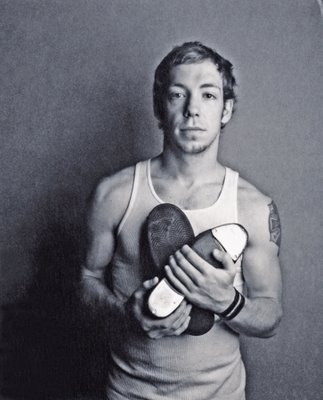
Shay Kuebler,(right) who did most of the choreography for today's performance of the 605 Collective, was not present (a very good dance engagement in Montreal was the reason) is a rising star (with Martin) in Canadian dance.
It would seem that these two, in cahoots with Amber Funk Barton, are bringing a fusion to our local scene. Those that love classical ballet will not go to modern dance and those into Butoh will go to contact improv but not to classical ballet.
This combination of many dance methods and types might help to bring the dance community together which is somewhat fractured. The Collective will perhaps draw more people who love dance. It would then be the audience that would help in bridging this dance gap. Amber Funk Barton and the 605 Collective might just represent a new form of dance. It is exciting to be living in Vancouver to see its birth and development.
And to any of my friends whom might look at my adoption of hip hop with incredulity all I can say in my defense is that there is hip hop and then there are these guys. And therin lies the difference!
Catharis: Asthetics: The effect of certain kinds of art, esp tragedy and music, in relieving or purging the emotions of an audience.
The Random House Dictionary of the English Language The Unabridged Edition

If there were reason for these miseries,
Then into limits could I bind my woes.
Titus from William Shakespeare's Titus Andronicus, III, Scene 1
Every man has a breaking point.
You can push a guy to the limit...But expect consequences.
Tag lines for Sam Peckinpah's Straw Dogs, 1971
Are we at all meant to sympathize with his endless, play-long sufferings, compared with which Job's are only noisy self-indulgences?
Harold Bloom on Titus Andronicus from his book Shakespeare The Invention of the Human, 1998
In 1972 Rosemary and I lived in Mexico City. Every day we drove in bumper to bumper traffic in the city's periférico or freeway. We worked long hours teaching high school and teaching English in large American companies like Colgate Palmolive, Richardson-Merrill and Westin Hotels. We had a daugther Ale 3 and a few month's old Hilary. We did not know to what extent we were living a life of extreme stress. We found out one Friday night when we went to see Sam Peckinpah's Straw Dogs with Susan George and Dustin Hoffman. While we had seen Peckinpah's previous blood bath, The Wild Bunch we were not ready for the close quarter (in one house) violence of this film. By the end I was cheering inside as Hoffman's character, David Sumner, blasted away one more villain with a shotgun. When we left I remember distinctly telling Rosemary, "This is the perfect film for a Friday night after a terrible week of having to drive agressively (you could not get into the freeway unless you did) and teaching spoiled and rich American kids." I remember adding, "It gave me the same feeling of peace and relief as when I used to go to Roman Catholic confession."
Last night Rosemary and I went to Bard On the Beach's production (the last perfromance) of Shakespeare's Titus Andronicus. I had read the play many times but I had never seen it performed on stage and I had never seen the film version. I expected an evening of catharsis.
While on the line-up to get in we noticed that a couple of actors were rehearsing a fight scene inside the Titus Andronicus tent. I told Rosemary, "If they have to rehearse this scene on the last night, after months of playing it, there has to be something wrong with this play. I am going to ask the director (Kim Collier, see photograph below) if she is here tonight."
Sitting in the front row with a nice and warm blanket while we munched on chocolate and feasted on the candied (with cheese, too) popcorn sold on the premises we had an enjoyable evening of theatre. Somehow Rosemary survived all the gory scenes, When Julie McIssac's Lavinia spewed out dark and sticky blood from her mouth (her tongue had been cut out by the evil Demetrius, Charles Gallant (photo top left) and Chiron, Kule Rideout), even I felt queasy.
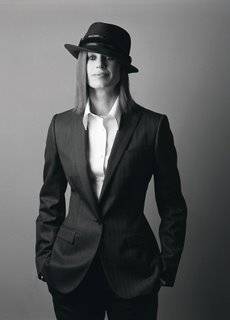
As we were leaving we ran into director Kim Collier so I was able to ask her a couple of questions. "Every fight scene in a play has to be rehearsed every day for safety reasons," Collier told me. When I asked her if directors attend every night she said,"By contract we are obliged only to attend the first performance. Tonight is only my second time. It is different with dance as choreographers are compelled to attend every performance."
As we drove home I tought about catharsis and why Titus Andronicus a play of revenge as much as The Straw Dogs was a play of revenge did not affect in me a such a feeling. The actors were excellent, the direction was top notch. The costumes were interesting and some of the dresses that Tamora the Queen of the Goths (Jennifer Lines) wore were beautiful. Her sons, Demetrius and Chiron were a fantastic surprise of costuming every time they appeared on stage. What was it?
In Vancouver we don't have to drive agressively nor worry about being stopped by a thirsty-for-a-bribe Mexican traffic cop. Life is more or less predictable and inflation is mostly in check. Life is good in Vancouver. Rosemary and I don't need a catharsis! I remember my grandmother saying, "Hay que tener la paciencia del santo." One must have the patience of the saint. The saint in question was the biblical Job. Nothing that could possibly happen to us (touch wood) could compare with that santo's and Titus Andronicus's woes.
What is Charlie Gallant holding in his hands? The quote is from Samuel Beckett and it reads: Fail. Fail Again. Fail Better. This is Gallant's favourite quote and it inspires him to press his limits when he is on the stage. Surely this young actor will be surprising us and thrilling us with performances to come.
Rosemary and I look forward to more of that popcorn when we see Christopher Gaze play King Lear next week.
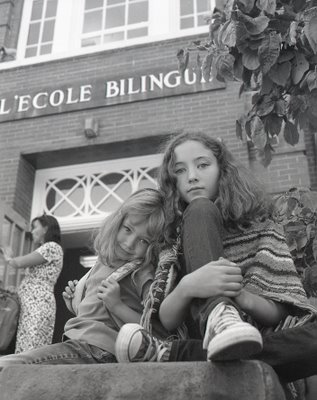
In my youth I used 35mm film cameras. They were light and somehow the world was at my feet because I owned a couple. With the advent of my largish and heavy Mamiya RB-67 the candid photographs went out the window and I became determined to use good studio lighting or good portable studio lighting. Portability of studio lighting is really at odds and the moment laziness sets in fewer and fewer pictures are taken.
But my friend Grant Simmons from Disc gave me about 30 rolls of Agfa (no longer made) IS0 400 120 film and I have been imagining my ungainly Mamiya as a lightweight and maneuverable 35. I have been taking more pictures. And best of all I have been going against the world trend by processing the film in my darkroom. The smell of fixer while not being the smell of my roses is comforting in the age of the CMOS chip.

Here you see three recent images. In one that's Rebecca and Lauren after school. Lauren is in the first grade and Rebecca is in the 6th (or grade 6 as they say here in Canada). In the second picture the girls are enjoing ice cream at Casa Gelato on Venables. Last week we gloried in being able to enjoy the treats on a hot day that made us forget that summer is really gone.
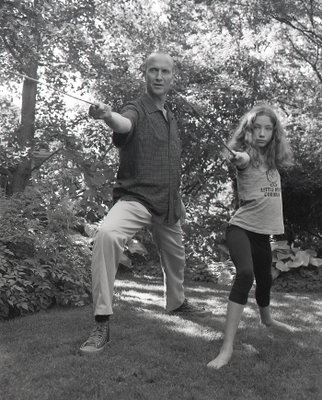
And in the last picture that's author, actor, fencer C.C. Humphreys giving Rebecca an "extemporaneus but at my request" fencing lesson to Rebecca. The foils were our garden bamboo sticks.
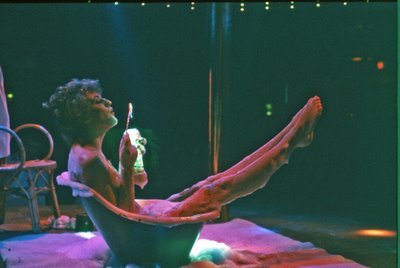
I photographed the owners of the Drake Hotel and the Marr Hotel, Jack Cooney and Darcy Taylor in January 1982 for an article that appeared in the March issue of Vancouver Magazine. The piece was called Young, Sexy & Well Heeled. The writer, and exotic dancer enthusiast Les Wiseman had found a way to hoodwink editor Malcolm Parry into running what definitely was not city magazine material. He had convinced Mac that the piece would be written with a business angle.
Here are Wiseman's first three paragraphs:
Down in Japanese town, you have to watch were you step. As you stand in a corner store at Powell and Dunlevy, waiting to buy a pack of cigarettes, a guy in navy blue ey bags and pinstripe nose will engage you in a one-sided conversation on the hopelessness of trying to get a job if you have been in the "joint" for the past six months. You offer him a couple of smokes, holding the door open as a long-haired fellow about 35 and legless, wheels his way past. Cheryl Ladd, peering up from the glossy cover of TV and Movie Star Parade, smiles cleanly unaware of this side of the tracks.
Across the street, the amateurishly drawn green-and-orange silhouette of a woman beckons you through the Marr hotel's butcher block door. Inside, in the dark, Kiss's thunderous heavy metal music drowns out your depressed maunderings. In the center of the room, swathed in red and blue stage lights, a tall, slim woman with soft brown hair down to her thighs, sways and sashays about the stage. Her face: the fragile cheekbones of a high fashion model. Her expression: serene, with the frail ethereal melancholia that brings lumps to the throats of strong men.
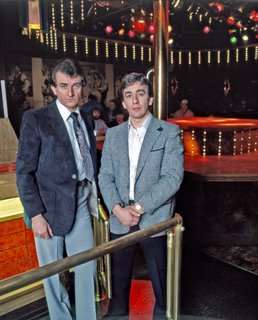
You fumble for a seat, and a heavy pint glass of cold, frothing beer is set in front of you. Fishing a deuce from your pocket and waving the waiter out of your field of vision, you sip through the frosty foam, all thoughts of the ugliness beyond these walls a vaguely remembered chimera. You relax, and bless the day you were born.
At last count, September 18, 2008 the strip bars of Vancouver are all gone except for two, The Penthouse and Brandy's.

Today Sunday was a Saturday for us because we had Rebecca and Lauren over. They no longer come on Saturdays. The occasional Sunday will have to do.
After Rebecca's noon piano lesson (we recently had that Chickering tuned) we had a home made pizza and we then went to see Josh Martin (left) and the 605 Collective at the Roundhouse presented by Dance Allsorts. While there were two performances today the early one at two was free for children under 12. Rosemary's response to the challenging (physically challenging, too) blend of hip hop, modern dance, karate (yes!) and other sports into dance was ambivalent. But she did admit that Josh Martin was superb so I smiled at that. Both Rosemary and I liked Told Him Twice with Josh Martin and his fellow 605 Collective Lisa Gelley.
Lauren, Rebecca and I had seen Martin before at Dancing on the Edge with Amber Funk Barton and Shay Kuebler. That evening at the Firehall we had sat near Crystal Pite who was blown away (I know because she told me) by that performance.

Shay Kuebler,(right) who did most of the choreography for today's performance of the 605 Collective, was not present (a very good dance engagement in Montreal was the reason) is a rising star (with Martin) in Canadian dance.
It would seem that these two, in cahoots with Amber Funk Barton, are bringing a fusion to our local scene. Those that love classical ballet will not go to modern dance and those into Butoh will go to contact improv but not to classical ballet.
This combination of many dance methods and types might help to bring the dance community together which is somewhat fractured. The Collective will perhaps draw more people who love dance. It would then be the audience that would help in bridging this dance gap. Amber Funk Barton and the 605 Collective might just represent a new form of dance. It is exciting to be living in Vancouver to see its birth and development.
And to any of my friends whom might look at my adoption of hip hop with incredulity all I can say in my defense is that there is hip hop and then there are these guys. And therin lies the difference!
Titus Andronicus & A Catharsis That Passed Me By
Saturday, September 20, 2008
Catharis: Asthetics: The effect of certain kinds of art, esp tragedy and music, in relieving or purging the emotions of an audience.
The Random House Dictionary of the English Language The Unabridged Edition

If there were reason for these miseries,
Then into limits could I bind my woes.
Titus from William Shakespeare's Titus Andronicus, III, Scene 1
Every man has a breaking point.
You can push a guy to the limit...But expect consequences.
Tag lines for Sam Peckinpah's Straw Dogs, 1971
Are we at all meant to sympathize with his endless, play-long sufferings, compared with which Job's are only noisy self-indulgences?
Harold Bloom on Titus Andronicus from his book Shakespeare The Invention of the Human, 1998
In 1972 Rosemary and I lived in Mexico City. Every day we drove in bumper to bumper traffic in the city's periférico or freeway. We worked long hours teaching high school and teaching English in large American companies like Colgate Palmolive, Richardson-Merrill and Westin Hotels. We had a daugther Ale 3 and a few month's old Hilary. We did not know to what extent we were living a life of extreme stress. We found out one Friday night when we went to see Sam Peckinpah's Straw Dogs with Susan George and Dustin Hoffman. While we had seen Peckinpah's previous blood bath, The Wild Bunch we were not ready for the close quarter (in one house) violence of this film. By the end I was cheering inside as Hoffman's character, David Sumner, blasted away one more villain with a shotgun. When we left I remember distinctly telling Rosemary, "This is the perfect film for a Friday night after a terrible week of having to drive agressively (you could not get into the freeway unless you did) and teaching spoiled and rich American kids." I remember adding, "It gave me the same feeling of peace and relief as when I used to go to Roman Catholic confession."
Last night Rosemary and I went to Bard On the Beach's production (the last perfromance) of Shakespeare's Titus Andronicus. I had read the play many times but I had never seen it performed on stage and I had never seen the film version. I expected an evening of catharsis.
While on the line-up to get in we noticed that a couple of actors were rehearsing a fight scene inside the Titus Andronicus tent. I told Rosemary, "If they have to rehearse this scene on the last night, after months of playing it, there has to be something wrong with this play. I am going to ask the director (Kim Collier, see photograph below) if she is here tonight."
Sitting in the front row with a nice and warm blanket while we munched on chocolate and feasted on the candied (with cheese, too) popcorn sold on the premises we had an enjoyable evening of theatre. Somehow Rosemary survived all the gory scenes, When Julie McIssac's Lavinia spewed out dark and sticky blood from her mouth (her tongue had been cut out by the evil Demetrius, Charles Gallant (photo top left) and Chiron, Kule Rideout), even I felt queasy.

As we were leaving we ran into director Kim Collier so I was able to ask her a couple of questions. "Every fight scene in a play has to be rehearsed every day for safety reasons," Collier told me. When I asked her if directors attend every night she said,"By contract we are obliged only to attend the first performance. Tonight is only my second time. It is different with dance as choreographers are compelled to attend every performance."
As we drove home I tought about catharsis and why Titus Andronicus a play of revenge as much as The Straw Dogs was a play of revenge did not affect in me a such a feeling. The actors were excellent, the direction was top notch. The costumes were interesting and some of the dresses that Tamora the Queen of the Goths (Jennifer Lines) wore were beautiful. Her sons, Demetrius and Chiron were a fantastic surprise of costuming every time they appeared on stage. What was it?
In Vancouver we don't have to drive agressively nor worry about being stopped by a thirsty-for-a-bribe Mexican traffic cop. Life is more or less predictable and inflation is mostly in check. Life is good in Vancouver. Rosemary and I don't need a catharsis! I remember my grandmother saying, "Hay que tener la paciencia del santo." One must have the patience of the saint. The saint in question was the biblical Job. Nothing that could possibly happen to us (touch wood) could compare with that santo's and Titus Andronicus's woes.
What is Charlie Gallant holding in his hands? The quote is from Samuel Beckett and it reads: Fail. Fail Again. Fail Better. This is Gallant's favourite quote and it inspires him to press his limits when he is on the stage. Surely this young actor will be surprising us and thrilling us with performances to come.
Rosemary and I look forward to more of that popcorn when we see Christopher Gaze play King Lear next week.
School, Gelato & A Fencing Lesson With C.C. Humphreys
Friday, September 19, 2008

In my youth I used 35mm film cameras. They were light and somehow the world was at my feet because I owned a couple. With the advent of my largish and heavy Mamiya RB-67 the candid photographs went out the window and I became determined to use good studio lighting or good portable studio lighting. Portability of studio lighting is really at odds and the moment laziness sets in fewer and fewer pictures are taken.
But my friend Grant Simmons from Disc gave me about 30 rolls of Agfa (no longer made) IS0 400 120 film and I have been imagining my ungainly Mamiya as a lightweight and maneuverable 35. I have been taking more pictures. And best of all I have been going against the world trend by processing the film in my darkroom. The smell of fixer while not being the smell of my roses is comforting in the age of the CMOS chip.

Here you see three recent images. In one that's Rebecca and Lauren after school. Lauren is in the first grade and Rebecca is in the 6th (or grade 6 as they say here in Canada). In the second picture the girls are enjoing ice cream at Casa Gelato on Venables. Last week we gloried in being able to enjoy the treats on a hot day that made us forget that summer is really gone.

And in the last picture that's author, actor, fencer C.C. Humphreys giving Rebecca an "extemporaneus but at my request" fencing lesson to Rebecca. The foils were our garden bamboo sticks.
A Vaguely Remembered Chimera
Thursday, September 18, 2008

I photographed the owners of the Drake Hotel and the Marr Hotel, Jack Cooney and Darcy Taylor in January 1982 for an article that appeared in the March issue of Vancouver Magazine. The piece was called Young, Sexy & Well Heeled. The writer, and exotic dancer enthusiast Les Wiseman had found a way to hoodwink editor Malcolm Parry into running what definitely was not city magazine material. He had convinced Mac that the piece would be written with a business angle.
Here are Wiseman's first three paragraphs:
Down in Japanese town, you have to watch were you step. As you stand in a corner store at Powell and Dunlevy, waiting to buy a pack of cigarettes, a guy in navy blue ey bags and pinstripe nose will engage you in a one-sided conversation on the hopelessness of trying to get a job if you have been in the "joint" for the past six months. You offer him a couple of smokes, holding the door open as a long-haired fellow about 35 and legless, wheels his way past. Cheryl Ladd, peering up from the glossy cover of TV and Movie Star Parade, smiles cleanly unaware of this side of the tracks.
Across the street, the amateurishly drawn green-and-orange silhouette of a woman beckons you through the Marr hotel's butcher block door. Inside, in the dark, Kiss's thunderous heavy metal music drowns out your depressed maunderings. In the center of the room, swathed in red and blue stage lights, a tall, slim woman with soft brown hair down to her thighs, sways and sashays about the stage. Her face: the fragile cheekbones of a high fashion model. Her expression: serene, with the frail ethereal melancholia that brings lumps to the throats of strong men.

You fumble for a seat, and a heavy pint glass of cold, frothing beer is set in front of you. Fishing a deuce from your pocket and waving the waiter out of your field of vision, you sip through the frosty foam, all thoughts of the ugliness beyond these walls a vaguely remembered chimera. You relax, and bless the day you were born.
At last count, September 18, 2008 the strip bars of Vancouver are all gone except for two, The Penthouse and Brandy's.
Wednesday, September 17, 2008

Sursum corda (lift up your hearts) from the Catholic Mass.
As soon as the priest would utter the magic words ite, missa est which in Latin means "go the Mass is over", I was out of the church like a light ready to play with my friends on the street. I knew the ropes and I always managed to arrive late for Mass but I made sure I made it before the Ofertory began. This was considered to be the minimum requirement to satisfying the Catholic dictum of attending Holy Mass every Sunday. I knew all this because I was raised a Catholic. My grandmother said her Holy Rosary at least 10 times per day. And to top it all I was sent to a Catholic boarding high school in Austin, Texas for 4 years.
In my four years there I received the best education of my life. The Brothers of the Holy Cross that taught me, taught me well and from the heart (as Jonathon Young's Father Flynn says in Doubt, below). I have kept correspondence with my last, remaining and living teacher from that school, Brother Edwin Reggio CSC to this day.
It was with that skepticism that comes from having been served well by my Catholic church upbringing that I attended tonight the Arts Club Theatre play Doubt by John Patrick Shanley at the Stanley Industrial Alliance Stage. Doubt is a very Catholic play set at the St. Nicholas School and Church in the Bronx in 1964.
My fears were all unfounded. I should have known better. To begin with the play was fronted by two of the best actors in the business, Jonathon Young (Father Flynn) and Gabrielle Rose (Sister Aloysius). The other two actors, Sasa Brown (Sister James) and Michèle Lonsdale Smith (Mrs. Muller) were not in the least intimidated by the virtuso competition and did just fine. I was a bit surprised in the beginning to see the previously voluptuous Sasa Brown (as seen in my photograph here) appear in nun's habits!
The play opened with a sermon from the pulpit in which Jonathon Young's Father Flynn somehow made up for all those masses I almost missed. It felt comforting to be back in church again. He was the perfect priest. I am sure Young would make the perfect serial killer, too.
But then I don't think I know the real Jonathon Young at all. The Jonathon Young that has been in my studio a few times has always shown up in his latest role and has always refused to be anybody else. Here you see him as Trout Stanley from last year's terrific play, Trout Stanley for Ruby Slippers. I remember asking Young to lean a bit to his right for my photograph and he answered, "Alex, Trout Stanley would only lean to the left, "and he then did just that.

I had never really seen Gabrielle Rose (top, left) in a role (that makes Iago a rank amateur) where I disliked her until tonight. Don't get me wrong, she was superb. She just simply convinced me to dislike her and when all roles are reversed with the "innocent" Sister James of Sasa Brown and she breaks down in tears I felt all kinds of sympathy for her. It was the same with Young's Father Flynn who goes from complete self-control and self-confidence to almost begging on his knees that I knew that this play will be hard to top this year. The ending is subtle and I was left with an almost comforting sense of doubt. Had I been just a bit daring I might have asked the clerically collared gentleman who was sitting in front of me what he thought of it all.

But then I could be wrong (about the play being hard to top) as I will be attending the last performance of Bard on the Beach's Titus Andronicus directed by Young's wife Kim Collier on Friday. Since all of these fine directors (lncluding Rachel Ditor the director of Doubt whom I once asked exactly what was a dramaturge and she just smiled!) and actors seem to be home grown, it is nice to know that they are all in the family and a fine family it is.
Doubt runs until October 12
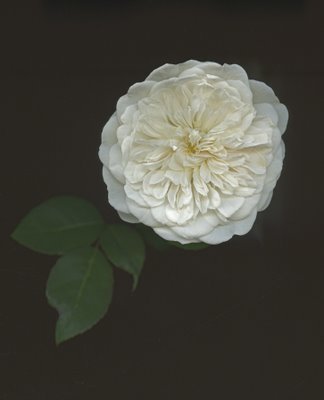
The Execution of the King - John Emerich Edward Dalberg, Lord Acton, Lectures on the French Revolution (LF ed.) [1910]
In the above book there is an interesting section of a very famous acquital during the time of the execution of Louis XVI. It is notable that Lord Acton insists in writing it as Lewis XVI!
One acquittal is remembered beyond all the rest. In every school and in every nursery of France the story continues to be told how Sombreuil, the governor of the Invalides, was acquitted by the judges, but would have been butchered by the mob outside if his daughter had not drunk to the nation in a glass filled with the warm blood of the last victim. They were taken home in triumph. Sombreuil perished in the Reign of Terror. His daughter married, and died at Avignon in 1823, at the height of the royalist reaction. The fame of that heroic moment in her life filled the land, and her heart was brought to Paris, to be laid in the consecrated ground where she had worshipped as a child, and it rests under the same gilded canopy that covers the remains of Napoleon. Many people believe that this is one of the legends of royalism which should be strung with the mock pearls of history. No contemporary mentions it, and it does not appear before 1801. Mlle. de Sombreuil obtained a pension from the Convention, but this was not included in the statement of her claims. An Englishman, who witnessed the release of Sombreuil, only relates that father and daughter were carried away swooning from the strain of emotion. I would not dwell on so well-worn an anecdote if I believed that it was false. The difficulty of disbelief is that the son of the heroine wrote a letter affirming it, in which he states that his mother was never afterwards able to touch a glass of red wine. The point to bear in mind is that these atrocious criminals rejoiced as much in a man to save as in a man to kill. They were servants of a cause, acting under authority.

As I walked aroung the garden today and looked at which roses were still going strong, Abraham Darby, St Swithun, Mary Rose, chinenis x odorata, Immortal Juno, Gruss an Aachen, I almost missed a white rose (only one in bloom) by the gate to the back lane. She is a climbing tea rose raised in by M. Robert in France in 1850. She was originally named Mlle. de Sombreuil but the name has been shortened to Sombreuil. She is incredibly white and her profile is almost flat as if someone had shaved off most of her with a very sharp straight razor. I find it amazing that in spite of the blood involved in the origin of her story there is no red anywhere in this pristine and beautiful, sweet smelling rose. I would have never noticed her as she was quiet in her dark corner which is perhaps a reason for her not flowering as freely as some of my other roses.
I cannot explain why but when I was scanning the rose I remembered one of my early heartbreaks. I was 21. Her name was Susy and I had gone to a party in a Buenos Aires suburb. It was was at an English young man's house by the name of Singer. I had purchased two tickets to also go to see a live performance of Astor Piazzolla at the Teatro Florida in downtown Buenos Aires. When the time came to leave the party I told Susy we had to go. She said, "I am having fun. Why don't we stay?" I replied,(What an idiot I was!), "I am not going to change my plans. I am going with you or without you." And that was that and I left. As I waited for the train it was evening. There is nothing more lonely and depressing than waiting for one when one's heart is broken.
I sat down at the smallish and intimate Teatro Florida. I tried not to notice the empty seat to my right. Piazzolla was powerful and electric. I almost forgot my pain until he began to play this slow and sorrowfully beautiful tango called La Milonga del Angel. Suddenly I felt a slight pressure on my right hand. And in my right ear I heard her whisper, "I changed my mind. I thought you would miss me."
It was in the quiet way that Susy made me notice her that is perhaps why I connected Sombreuil with her today. Soon after that concert (in the middle of a bitterly cold and gray Buenos Aires winter) Susy left me for a violinist (a much older man) at the Teatro Colón orchestra. I returned to Buenos aires in my late 50s. I rang the bell at her house and when she opened the door she said, "Aren't you going to kiss me?
La vida es un tango. "Life is a tango," Mexicans like to say.
I received an email from Susy a few years later and then I found out that she had died of cancer.
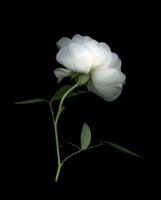
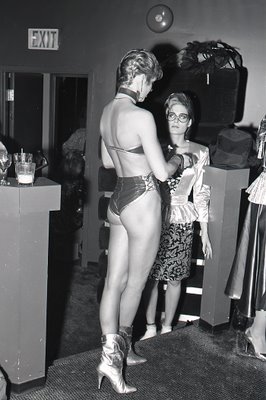
My grandmother used to tell me stories about her life in Spain and in the Philippines in the 19th century. One I will never forget is about the virstuoso Spanish violinist and composer Pablo de Sarasate and of his grand snub to a Paris salon lady who invited him to dine 'avec votre violon'. 'Chère Madame,' he replied, 'je viendrai avec plaisir, mais mon violon ne dîne pas.' (I'll come with pleasure but my violin does not dine.)
Most of my life as a photographer (I have never told anybody I used to play the alto saxophone) I have been invited to functions and such and I have been asked to bring my camera. In just about every case I have managed to leave my camera home. I hate taking pictures at functions. Some photographers call these "grin and grip". But when paid I have done a few. Most were for Canadian Pacific Limited and I photographed retirements (at the Terminal City Club) of their executives. I hated doing this especially as I found them glorified roasts where the underlings took advantage of making fun of the retiree. I would look at my wife Rosemary with sad eyes, before one of these evenings. She would look back at me and I knew exactly what she was thinking, "We need the money. You go." And I did.
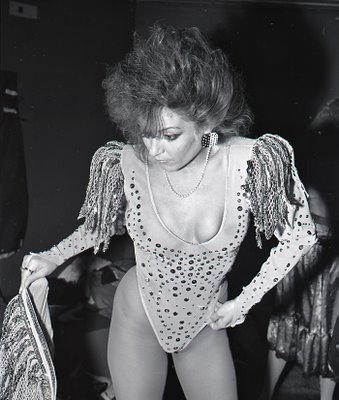
There is one function that I did attend. I suspect that the writer who told me to go, Les Wiseman who at the time (1988) was working for Vancouver Magazine, wanted to look at the pictures I was going to take. Even though there was no chance that the magazine was ever going to run them. It was a fashion show in which the models were all strippers and it was held in Systems which was the hottest night club in town at the time. It was on Richards Street. It is still there under another name. I was given the exclusivity of being able to take pictures in the dressing room. There are quite a few of the best of the exotic dancers of the time here. I have self-censored the pictures so as not to offend any young readers.
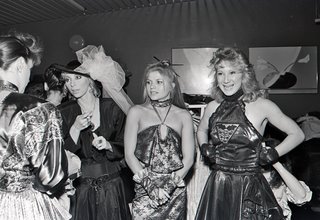

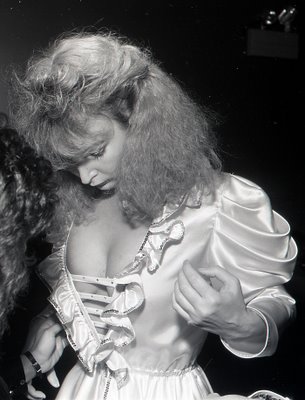
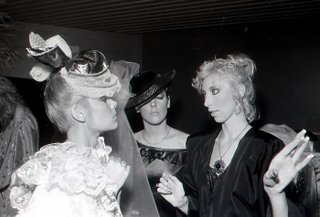
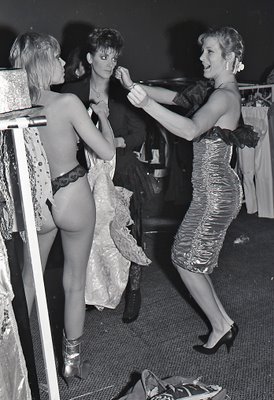
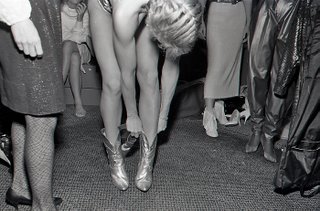
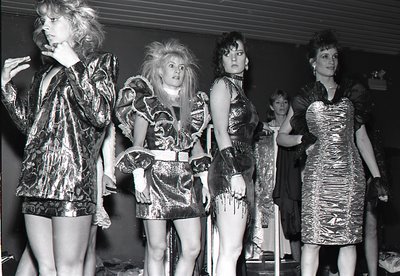
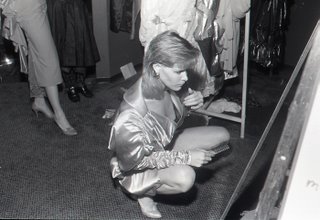
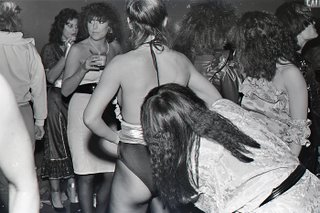
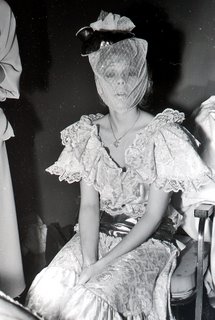
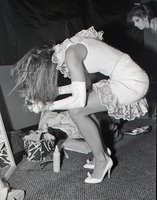
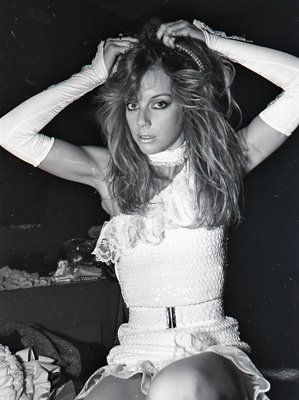

Sursum corda (lift up your hearts) from the Catholic Mass.
As soon as the priest would utter the magic words ite, missa est which in Latin means "go the Mass is over", I was out of the church like a light ready to play with my friends on the street. I knew the ropes and I always managed to arrive late for Mass but I made sure I made it before the Ofertory began. This was considered to be the minimum requirement to satisfying the Catholic dictum of attending Holy Mass every Sunday. I knew all this because I was raised a Catholic. My grandmother said her Holy Rosary at least 10 times per day. And to top it all I was sent to a Catholic boarding high school in Austin, Texas for 4 years.
In my four years there I received the best education of my life. The Brothers of the Holy Cross that taught me, taught me well and from the heart (as Jonathon Young's Father Flynn says in Doubt, below). I have kept correspondence with my last, remaining and living teacher from that school, Brother Edwin Reggio CSC to this day.
It was with that skepticism that comes from having been served well by my Catholic church upbringing that I attended tonight the Arts Club Theatre play Doubt by John Patrick Shanley at the Stanley Industrial Alliance Stage. Doubt is a very Catholic play set at the St. Nicholas School and Church in the Bronx in 1964.
My fears were all unfounded. I should have known better. To begin with the play was fronted by two of the best actors in the business, Jonathon Young (Father Flynn) and Gabrielle Rose (Sister Aloysius). The other two actors, Sasa Brown (Sister James) and Michèle Lonsdale Smith (Mrs. Muller) were not in the least intimidated by the virtuso competition and did just fine. I was a bit surprised in the beginning to see the previously voluptuous Sasa Brown (as seen in my photograph here) appear in nun's habits!
The play opened with a sermon from the pulpit in which Jonathon Young's Father Flynn somehow made up for all those masses I almost missed. It felt comforting to be back in church again. He was the perfect priest. I am sure Young would make the perfect serial killer, too.
But then I don't think I know the real Jonathon Young at all. The Jonathon Young that has been in my studio a few times has always shown up in his latest role and has always refused to be anybody else. Here you see him as Trout Stanley from last year's terrific play, Trout Stanley for Ruby Slippers. I remember asking Young to lean a bit to his right for my photograph and he answered, "Alex, Trout Stanley would only lean to the left, "and he then did just that.

I had never really seen Gabrielle Rose (top, left) in a role (that makes Iago a rank amateur) where I disliked her until tonight. Don't get me wrong, she was superb. She just simply convinced me to dislike her and when all roles are reversed with the "innocent" Sister James of Sasa Brown and she breaks down in tears I felt all kinds of sympathy for her. It was the same with Young's Father Flynn who goes from complete self-control and self-confidence to almost begging on his knees that I knew that this play will be hard to top this year. The ending is subtle and I was left with an almost comforting sense of doubt. Had I been just a bit daring I might have asked the clerically collared gentleman who was sitting in front of me what he thought of it all.

But then I could be wrong (about the play being hard to top) as I will be attending the last performance of Bard on the Beach's Titus Andronicus directed by Young's wife Kim Collier on Friday. Since all of these fine directors (lncluding Rachel Ditor the director of Doubt whom I once asked exactly what was a dramaturge and she just smiled!) and actors seem to be home grown, it is nice to know that they are all in the family and a fine family it is.
Doubt runs until October 12
A Glass Of Warm Blood & Piazzolla's La Milonga Del Angel
Tuesday, September 16, 2008

The Execution of the King - John Emerich Edward Dalberg, Lord Acton, Lectures on the French Revolution (LF ed.) [1910]
In the above book there is an interesting section of a very famous acquital during the time of the execution of Louis XVI. It is notable that Lord Acton insists in writing it as Lewis XVI!
One acquittal is remembered beyond all the rest. In every school and in every nursery of France the story continues to be told how Sombreuil, the governor of the Invalides, was acquitted by the judges, but would have been butchered by the mob outside if his daughter had not drunk to the nation in a glass filled with the warm blood of the last victim. They were taken home in triumph. Sombreuil perished in the Reign of Terror. His daughter married, and died at Avignon in 1823, at the height of the royalist reaction. The fame of that heroic moment in her life filled the land, and her heart was brought to Paris, to be laid in the consecrated ground where she had worshipped as a child, and it rests under the same gilded canopy that covers the remains of Napoleon. Many people believe that this is one of the legends of royalism which should be strung with the mock pearls of history. No contemporary mentions it, and it does not appear before 1801. Mlle. de Sombreuil obtained a pension from the Convention, but this was not included in the statement of her claims. An Englishman, who witnessed the release of Sombreuil, only relates that father and daughter were carried away swooning from the strain of emotion. I would not dwell on so well-worn an anecdote if I believed that it was false. The difficulty of disbelief is that the son of the heroine wrote a letter affirming it, in which he states that his mother was never afterwards able to touch a glass of red wine. The point to bear in mind is that these atrocious criminals rejoiced as much in a man to save as in a man to kill. They were servants of a cause, acting under authority.

As I walked aroung the garden today and looked at which roses were still going strong, Abraham Darby, St Swithun, Mary Rose, chinenis x odorata, Immortal Juno, Gruss an Aachen, I almost missed a white rose (only one in bloom) by the gate to the back lane. She is a climbing tea rose raised in by M. Robert in France in 1850. She was originally named Mlle. de Sombreuil but the name has been shortened to Sombreuil. She is incredibly white and her profile is almost flat as if someone had shaved off most of her with a very sharp straight razor. I find it amazing that in spite of the blood involved in the origin of her story there is no red anywhere in this pristine and beautiful, sweet smelling rose. I would have never noticed her as she was quiet in her dark corner which is perhaps a reason for her not flowering as freely as some of my other roses.
I cannot explain why but when I was scanning the rose I remembered one of my early heartbreaks. I was 21. Her name was Susy and I had gone to a party in a Buenos Aires suburb. It was was at an English young man's house by the name of Singer. I had purchased two tickets to also go to see a live performance of Astor Piazzolla at the Teatro Florida in downtown Buenos Aires. When the time came to leave the party I told Susy we had to go. She said, "I am having fun. Why don't we stay?" I replied,(What an idiot I was!), "I am not going to change my plans. I am going with you or without you." And that was that and I left. As I waited for the train it was evening. There is nothing more lonely and depressing than waiting for one when one's heart is broken.
I sat down at the smallish and intimate Teatro Florida. I tried not to notice the empty seat to my right. Piazzolla was powerful and electric. I almost forgot my pain until he began to play this slow and sorrowfully beautiful tango called La Milonga del Angel. Suddenly I felt a slight pressure on my right hand. And in my right ear I heard her whisper, "I changed my mind. I thought you would miss me."
It was in the quiet way that Susy made me notice her that is perhaps why I connected Sombreuil with her today. Soon after that concert (in the middle of a bitterly cold and gray Buenos Aires winter) Susy left me for a violinist (a much older man) at the Teatro Colón orchestra. I returned to Buenos aires in my late 50s. I rang the bell at her house and when she opened the door she said, "Aren't you going to kiss me?
La vida es un tango. "Life is a tango," Mexicans like to say.
I received an email from Susy a few years later and then I found out that she had died of cancer.

Pablo De Sarasate's Violin Does Not Dine
Monday, September 15, 2008

My grandmother used to tell me stories about her life in Spain and in the Philippines in the 19th century. One I will never forget is about the virstuoso Spanish violinist and composer Pablo de Sarasate and of his grand snub to a Paris salon lady who invited him to dine 'avec votre violon'. 'Chère Madame,' he replied, 'je viendrai avec plaisir, mais mon violon ne dîne pas.' (I'll come with pleasure but my violin does not dine.)
Most of my life as a photographer (I have never told anybody I used to play the alto saxophone) I have been invited to functions and such and I have been asked to bring my camera. In just about every case I have managed to leave my camera home. I hate taking pictures at functions. Some photographers call these "grin and grip". But when paid I have done a few. Most were for Canadian Pacific Limited and I photographed retirements (at the Terminal City Club) of their executives. I hated doing this especially as I found them glorified roasts where the underlings took advantage of making fun of the retiree. I would look at my wife Rosemary with sad eyes, before one of these evenings. She would look back at me and I knew exactly what she was thinking, "We need the money. You go." And I did.

There is one function that I did attend. I suspect that the writer who told me to go, Les Wiseman who at the time (1988) was working for Vancouver Magazine, wanted to look at the pictures I was going to take. Even though there was no chance that the magazine was ever going to run them. It was a fashion show in which the models were all strippers and it was held in Systems which was the hottest night club in town at the time. It was on Richards Street. It is still there under another name. I was given the exclusivity of being able to take pictures in the dressing room. There are quite a few of the best of the exotic dancers of the time here. I have self-censored the pictures so as not to offend any young readers.












Sunday, September 14, 2008
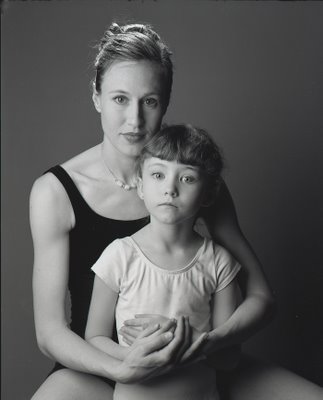
It seems that a few days ago when Rosemary called Hilary as to when we were going to get Rebecca and Lauren, Rosemary heard Rebecca say, "I don't want to go. I want to stay here so I can play with my friends." It was inevitable that after having Rebecca with us every weekend for 10 years this had to happen. It just didn't seem that it would have happened so soon.
My grandmother catered to my tastes in sweets because she liked sweets. She and I both seemed to have a similar taste in films: war pictures, westerns and films with dashing swordsmen. If she didn't she never told me. Going out for an afternoon (and sometimes late evenings) with Abue was always a pleasant adventure. We would go in to see a movie and as soon as it was finished we would walk down Lavalle (in the 50s this Buenos Aires street was a Broadway of movie houses) and slip into another one.
Perhaps Abue only had to compete with my toy soldier collection. There was no TV. There were no computer games. I don't recall one moment when she was ever angry at me. She always singled me out as being artistic because I had inherited the talent from her. I felt special. I loved her. Until she died in the early 70s I had a lively grandson/grandmother relationship. But then she was the only grandparent I ever had.
But with Rebecca (on the other side of the equation as I am the grandparent) I cannot fathom what she might be thinking. She also has all her grandparents nearby in Vancouver.
On Saturday I took her to the garden and lay 8 paper napkins in a row. There was wind so I had to put a pebble on each. I explained to Rebecca that each napkin represented a decade. I showed her where she was and where Rosemary was. I showed her the 32 years that represented the years that Rosemary worked for Mariposa before she (and most of the others ) was summarily let go without compensation as Mariposa cited bankruptcy. I told Rebecca that perhaps the most important meaning in her Aby's (as she calls Rosemary) life was her relationship with her grandchildren and especially her. I asked her if it was too much to sacrifice, pointing out the long row of white napkins in front of her, to spend one day of the week with Rosemary. She didn't reply and I have no idea what she thought of my explanation. I could not tell her that I too, felt like Rosemary and my life would have very little meaning without her.
Today Rosemary, Abraham Rogatnick and I went to a salon at the home of Colin (head of the Canadian Music Centre in Vancouver) and Winnie Miles to a preview concert by the Erato Ensemble. Just at about the end, tenor William George sang Ariel Ramirez's Alfonsina y El Mar. This Argentine zamba (similar in some ways to the Brazilian variety but slower, sadder and written with a z) broke my heart with nostalgia. The composer wrote it for the Argentine folk singer Mercedes Sosa. The Alfonsina of the song was an Argentine poet of note, Alfonsina Storni, 1892-1938) who striken with breast cancer, sent her last poem Voy a dormir ("I'm going to sleep") to the Buenos Aires daily La Nación . The following day she committed suicide, by walking into the sea at the La Perla beach in Mar del Plata, Argentina
When we got home I searched for the Mercedes Sosa version on the net and cried. It got worse when I listened to Sosa's take on Chilean Violeta Parra's Gracias a la Vida , Thanks to life. This was the very title I used for a sequence of photographs of Rebecca with her first ballet teacher, Andrea Hodge in 2004.
Alfonsina y el Mar

It seems that a few days ago when Rosemary called Hilary as to when we were going to get Rebecca and Lauren, Rosemary heard Rebecca say, "I don't want to go. I want to stay here so I can play with my friends." It was inevitable that after having Rebecca with us every weekend for 10 years this had to happen. It just didn't seem that it would have happened so soon.
My grandmother catered to my tastes in sweets because she liked sweets. She and I both seemed to have a similar taste in films: war pictures, westerns and films with dashing swordsmen. If she didn't she never told me. Going out for an afternoon (and sometimes late evenings) with Abue was always a pleasant adventure. We would go in to see a movie and as soon as it was finished we would walk down Lavalle (in the 50s this Buenos Aires street was a Broadway of movie houses) and slip into another one.
Perhaps Abue only had to compete with my toy soldier collection. There was no TV. There were no computer games. I don't recall one moment when she was ever angry at me. She always singled me out as being artistic because I had inherited the talent from her. I felt special. I loved her. Until she died in the early 70s I had a lively grandson/grandmother relationship. But then she was the only grandparent I ever had.
But with Rebecca (on the other side of the equation as I am the grandparent) I cannot fathom what she might be thinking. She also has all her grandparents nearby in Vancouver.
On Saturday I took her to the garden and lay 8 paper napkins in a row. There was wind so I had to put a pebble on each. I explained to Rebecca that each napkin represented a decade. I showed her where she was and where Rosemary was. I showed her the 32 years that represented the years that Rosemary worked for Mariposa before she (and most of the others ) was summarily let go without compensation as Mariposa cited bankruptcy. I told Rebecca that perhaps the most important meaning in her Aby's (as she calls Rosemary) life was her relationship with her grandchildren and especially her. I asked her if it was too much to sacrifice, pointing out the long row of white napkins in front of her, to spend one day of the week with Rosemary. She didn't reply and I have no idea what she thought of my explanation. I could not tell her that I too, felt like Rosemary and my life would have very little meaning without her.
Today Rosemary, Abraham Rogatnick and I went to a salon at the home of Colin (head of the Canadian Music Centre in Vancouver) and Winnie Miles to a preview concert by the Erato Ensemble. Just at about the end, tenor William George sang Ariel Ramirez's Alfonsina y El Mar. This Argentine zamba (similar in some ways to the Brazilian variety but slower, sadder and written with a z) broke my heart with nostalgia. The composer wrote it for the Argentine folk singer Mercedes Sosa. The Alfonsina of the song was an Argentine poet of note, Alfonsina Storni, 1892-1938) who striken with breast cancer, sent her last poem Voy a dormir ("I'm going to sleep") to the Buenos Aires daily La Nación . The following day she committed suicide, by walking into the sea at the La Perla beach in Mar del Plata, Argentina
When we got home I searched for the Mercedes Sosa version on the net and cried. It got worse when I listened to Sosa's take on Chilean Violeta Parra's Gracias a la Vida , Thanks to life. This was the very title I used for a sequence of photographs of Rebecca with her first ballet teacher, Andrea Hodge in 2004.
Alfonsina y el Mar
Saturday, September 13, 2008
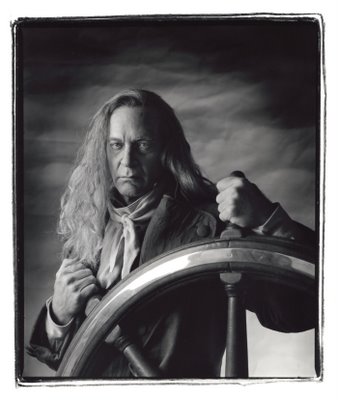
In 1959 one of my more sophisticated roomates, Dan Sherrod at St. Edward's High School in Austin Texas was into European sportscars (his father was the Aston Martin dealer in Midland, Texas), and esoteric stuff that was always in good taste. It was Dan who bought a record by a then almost unknown comedian Shelley Berman. The album was called Inside Shelly Berman.
Nobody should go through life without hearing his views on buttermilk (particularly what a glass of the stuff looks like after you have emptied it). Thanks to Shelley Berman I have never tried this particular lactic product.
Luckily Berman never spoke on yogurt or I would have never tried it. But it was not until I was 21 and in the Argentine Navy that I tried it. My secretary Edna Gahan came in one day with a jar of peach yogurt from a then renowned purveyor of milk products called La Vascongada. She was so obviously relishing it and she noticed that I had noticed. She offered me some but I refused telling her that I would never partake of rotten milk. She smiled and insisted. I have loved yogurt since.
At about that time I would be invited for high tea on weekends to my Uncle Freddy and Aunt Iris's. I never missed these even though I had to share the table with my boring first cousin (about my age) John Hayward. Aunt Iris made the best deviled ham on earth. I could stomach John's comments on his love of opera and in particular Wagner's operas as long as I had that deviled ham on the side.
By 1991 I had found that opera was not only not boring but fantastic. But I drew the line with Wagner. Then the Georgia Straight assigned me to photograph baritone Tom Fox who had come to town to sing Wagner's The Flying Dutchman.

I called up my friend James Delgado (right) who was then the Director of the Vancouver Maritime Museum. He told me he had a ship's wheel. I now had to find some sort of sunset backdrop for my concept shot of the Flying Dutchman. I went to Flashpoint and asked owner Berndt if he had such a thing. He looked at me and as if everybody asked for these particular backdrops every day he answered, "Do you want it with cumulus or stratus clouds?" I managed to stick the huge canvas roll in my wife's Audi 5000 (it was a big car) and took it to the Maritime Museum. Tom Fox looked the part and I was charmed.
Doug Tuck, then publicist for Vancouver Opera was so happy with my pictures that he offered to trade some for good tickets. Rosemary and I went with a bit of trepidation. We loved the Flying Dutchman.
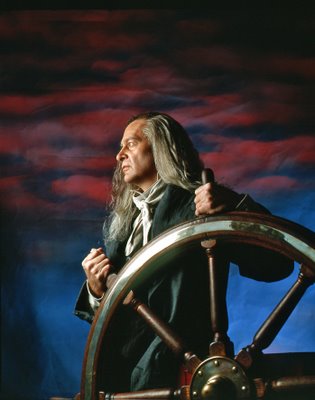
Cousin John Hayward died in Toronto a few years after we saw that opera. I had a chance to visit him in Toronto. I found that he was urbane, interesting and certainly not boring. We had a lovely time together. John sent me a letter shortly after telling me how pleased he was that we had finally hit it off. My only regret is that I should have given him and that peach yogurt an earlier try. I would have been a better person for it.
Cousin John should I try buttermilk?
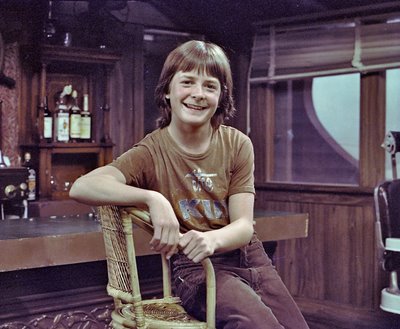
Last night, while preparing my projected lecture (I talk and project jpgs from a CD through a lap top connected to a digital projector) I found a devastatingly disturbing portrait of great American photographer Margaret Bourke-White. The portrait was taken by Life Magazine photographer Alfred Eisenstaedt (1898 - 1995) in March 1959. Bourke-White who had taken the first cover for Life Magazine in September 1936 and flown in bombing mission (the first woman) in January 23, 1943 over Tunis she was previously and dashingly photographed by Eisenstaedt. The difference between the pictures made me think on not only how Bourke-White's career ended quite suddenly around 1953 when she learned she had Parkinson's but also how many of my friends (6) here in Vancouver have that terrible disease. I also know that Edward Weston, ultimately stopped taking photographs because of the crippling disease.
A couple of years back I had a student, Alan Jacques in my class at Focal Point. He had Parkinson's and he told me once, "I have my good days and my bad days. And today is a good one." This cheerful and talented photographer had mastered a special technique. He used wide angle lenses (they tend to minimize shake) and he opted for Nikon FM or FM-2s. He held these cameras firmly on his forhead and would use a wide stance with his legs and get close to his subjects. He shot beautiuful nudes in my nude photography class. A few months back I ran into Jacques whose photography business is going strong. I would suspect that this is one instance where digital photography has become a distinct asset.
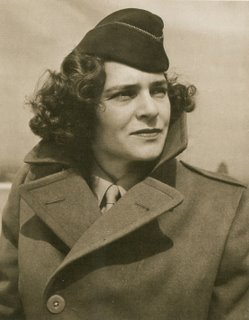
I have heard of various photographers in the past who have been so in spite of being clinically blind. It seems to me that Parkinson's must then be the cruelest of all diseases to hit a photographer. Every morning when I wake up (more and more I do this) I check my hands.
In 1978 I took still photographs for the Vancouver CBC. One of my jobs was to photograph drama. The particular drama that took me to studio 40 one day was a show called Leo and Me. It featured Brent Carver (Leo) and a young boy (the me of Leo and Me) called Michael J. Fox. Years after I would go into my files and look at Leo and Me and go to throw them away. And then for who knows what reason I kept them. Here is one of the very young Michael J. Fox. He was a cheerful kind of kid and everybody on the set loved him. How were we to know?
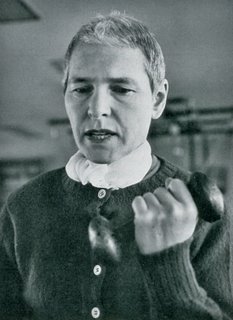
In 2002, an investigation was launched into Leo and Me after an unusual cluster of Parkinson's disease cases was noted among former cast and crew members of the show. Fox and director Don Williams were among the four with the disease, along with a writer and a cameraman

The story below is a story that needs the personal experience, wit and style of John Lekich. So I cede today's blog to him. Lekich has previously written two other guest blogs here and here.
Perhaps you think that punk rockers have no heart – that they are simply serial-puking cynics with safety pins stuck in all the wrong places. Thanks to a consummate gentleman known as Randy Rampage, I know better. His generous role in my sputtering love life all came back to me when Alex innocently asked: “Who was in Randy’s Cadillac with you anyway?”
I should explain that, many years ago, I had a fierce crush on a gorgeous blonde who has since attained an august reputation in local journalism circles. (For reasons of discretion, she will henceforth be referred to as Betty Bombshell.) My well-known adoration earned me little more than pitying looks from my fellow freelancers and the occasional medicinal glass of scotch from a sympathetic editor. All this changed when I made the acquaintance of Mr. Rampage who encouraged me to confront Betty with my feelings. When I explained that I was clearly out of Betty’s league, Randy related his own story about a seemingly unattainable blonde. “I worked up enough courage to ask her if she liked red wine,” he said. The gleam in his eye told the rest of the story, which he finished off with: “You just never know.”
I thought nothing more about it until – thanks to Alex’s vast social network - I found myself sharing a table at The Railway Club with Rampage, his fellow musician Zippy Pinhead, and none other than Betty herself. I recall stammering quite a bit. Mr. Rampage grasped the situation and – toward the end of lunch - asked Betty and me if we’d ever ridden in the backseat of a Cadillac. When we both responded negatively, he said: “Well, you’re going to now.” I recall that Mr. Pinhead also wanted to sit in the backseat, which had more space than my living room couch. Nevertheless, Mr. Rampage continually repeated that there was no room. When Zippy persisted, Randy barked: “You’re sitting in front!”
While I was unable to conquer my shyness, my proximity to the lovely Betty made for a cherished memory. After all these years, I continue to regard Mr. Rampage as alternative music’s answer to Miss Lonely Hearts. And – when I finally took his advice to become a little bolder with women - I discovered he was right. You just never know.
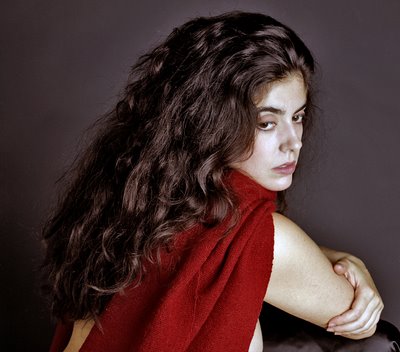
When I photographed Ana in my studio around 8 years ago in my studio she wore my mother's red rebozo. This red rebozo was given to my mother in 1952 when she visited Mexico in preparation for us moving there from Buenos Aires. The rebozo is of very rough and raspy cotton and the vegetable dye is of the purest red I have ever seen. I store it in our wooden chest from Olinalá, Guerrero, Mexico. It has a sweet smell not unlike sandalwood but with more fruit in the scent. I have used it to photograph many beautiful women and I take it to my Focal Point photography classes and make my students use it as a prop in our life figure classes.
I do think that Ana, the Portuguese Bombshell's white skin has a particular affinity to the red of my mother's rebozo.
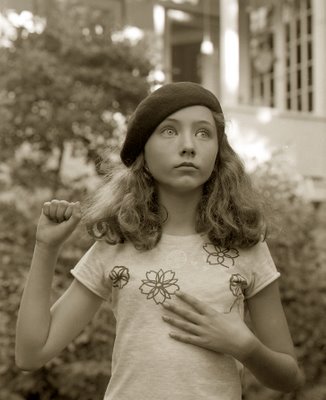
Today's blog really had its origins sometime in 1964 when I started smoking a pipe. My friend Robert Hijar was studying to get a fine arts degree at the University of the Americas in Mexico City and I admired his bohemian ways. While I was not a skirt chaser (I was much too shy for that sort of thing) I was jealous of Robert's many women. This attraction that women had for him had to do (I thought) because of his bohemian ways and that pipe. I began to smoke a pipe and wherever Robert and I went we always had a pipe attached to our mouth. I started with the usual aromatic blends like Cherry Blend and Sugar Barrel but settled on Edgeworth and in my later years on Three Nuns.
In 1967 I visited Robert in San Francisco. He was living in the Haight Ashbury area. He was surrounded by hippies and Robert still had many of the females after him. In spite of my pipe I was ignored by them. Robert convinced me to buy a new-fangled pipe made of pyrolytic carbon and hard rubber. This was a pipe you could wash in soap and water if you wanted to. I never did warm up to it as the smoke that entered my mouth seemed to be hotter that that of a briar pipe. While the pipe did not need to broken in it always tasted harsh.
I gave up the pipe and cigars sometime around 1992. My daughter Ale sent me an image from Lillooet that made me recall the pipe and a beret I had worn when I first came to Vancouver in 1975. I had thought that for me to stand out as a photographer in Vancouver I had to look different so I purchased a French beret like the one my Basque ancestors wore. My friend John Lekich asserts that not only did I wear a beret and smoke a pipe but I also wore a cape. He must be wrong as I have never owned one.

Ale in her email with the photograph of me with the beret and pipe told me it was her favourite self portrait of her father. I had to correct her and tell her that sometime in 1977 Rosemary had taken this photograph and I had printed it with an oval cutout to make it look old.
A few weeks ago Rebecca said she loved berets and that she wanted a red one. I knew I had this black one and gave it to her on Saturday. It was a hit and she kept going to the bathroom to look at herself in the mirror. Yesterday, Sunday when she arrived in the afternoon she said to me (while wearing the beret), "I am Che," and she brought up her right hand to her face and formed a fist.
I took some snaps of Rebecca with the beret in the TV room and then with two frames left we went out to the garden where there was more light. She insisted, "Who shaves the barber? I have to take your picture." I took one frame and then she took the next. Here you see the results.
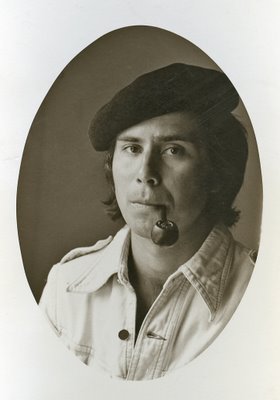
I wonder if I should have done what I did in the end. Rebecca seemed to have shaky knowledge on who Che Guevara was so I told her, "Let me show you my favourite photograph of him." And I did. I showed her the picture of Che dead on that slab taken in the laundry area in Vallegrande, Bolivia. She looked at it and was repelled. Previously to that she wanted me to photograph her with a pipe. She put the pipe in her mouth and almost spit it out, "It tastes of tobacco!" she shouted. At least I got that one right.

There is no way that George Cukor's wonderful 1938 film The Women can possibly work in its 2008 incarnation. I won't bother to see it. How could anybody top this cast: Norma Shearer, Joan Crawford, Rosalind Russell, Paulette Goddard, Joan Fontaine and the unflappable, scary but ultimately kind Marjorie Main?
I recall that no men are ever seen and the only walk on male is a dog.
I feel the same about my very own women. Yesterday was a perfect day with all the women of my life present and accounted for and all at home.
Hilary's husband, Bruce Stewart has a new schedule which means we no longer get Lauren and Rebecca on Saturdays but on Sundays. This will probably mean no Sunday night film as the girls will have to go home early because of Monday school. We will also miss the lazy Saturday afternoon dinners with Hilary arriving from work. Since Bruce was always working I was the only man around besides Rosemary's male cat Toby. My exclusive isolation might be over.

There is one benefit to the change if we can somehow convince the Stewart family that Saturday evening dinners at our place will be welcomed. What made our family dinner even better yesterday was the presence of my other daughter Ale who was in Vancouver for the weekend. Our family was complete and I took advantage and took some pictures of the girls and then one with Bruce.
Alas even though I had thought the film in my camera was ISO 400 and I exposed it as such I was shocked to find out that the film in question was Plus-X ISO 100. I processed the film at double the processing time (from almost 5 to almost 11 minutes). While the negatives had a higher contrast they are not bad.
The menu last night was:
1. Barbecued pork loin (Stubb's Pork Marinade from Austin, Texas) served with Keen's mustard.
2. Cucumber salad.
3. Sliced tomatoes brought by Ale from her Lillooet garden.
4. Fresh corn on the cob
5. Mashed potatoes mixed with mashed carrots with lots of butter and cream.
We accompanied it all with my special iced tea (made with Russian Caravan tea) and Rosemary made a Pavlova with fresh peaches, strawberries and cream. Hilary insisted in adding Argentine dulce de leche. An almost perfect evening made perfect when I salvaged the grossly underexposed film.
Recipe for Iced Tea
1. 14 heaping teaspoons of loose Russian Caravan tea.
2. 6 cloves
3. 1 large tablespoon cinnamon
4. 1 teaspoon nutmeg
5. A large handufl of fresh mint
Pour just boiling water into large teapot (2 litre) and allow to steep for 10 minutes. Strain into large pot. Boil more water and re-fill teapot without adding any more ingredients. Steep for 10 minutes.
To the pot add the juice of 8 to 9 lemons and 8 oranges (strained). Sweeten to taste. The smoky Russian Caravan cuts the sweetness so more sugar might be needed. The secret to this tea is to score the pressed lemons with a knife and to throw them into the mixture for at least half a day in the fridge. When your guests arrive pour tea into a large pitcher and add ice to dilute the strong mixture to taste.

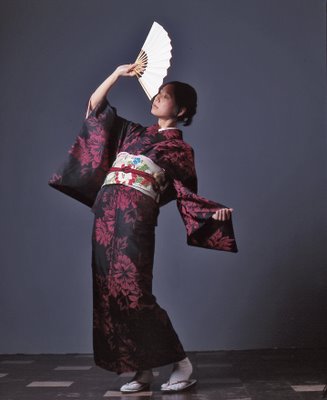
I have been through this avenue before but not in colour. I have written about Malcolm Parry's privileged view. He maintains that the masses look up and the few, privileged, look down. Everybody looks up at tall buildings. The very few who can, get on the roof and look down. It helps that Mr. Parry is very tall and he is able to shoot down with his camera. He is renowned in how his extra height allows him to capture gossip cleavage like no other in his profession.
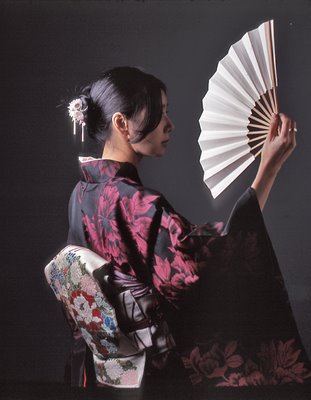
I have my own definition of the privileged view which has nothing to do with height. A couple of years ago the Georgia Straight asked me to photograph three rock bands inside Bradley's (a downtown strip joint). Don't ask me why it was that the Straight wanted this. But I took it seriously. Everybody can see a stripper on stage. But few get a glimpse into what happens in the dressing room. I had to go through a few Italian named bikers before I got a green light for the photograph. This was and is indeed a privileged view.
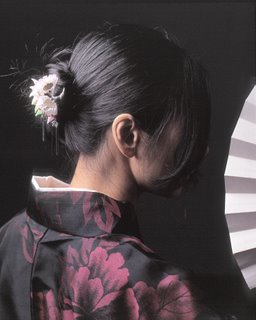
When Helen knocked on the door of my studio, I opened to find her dressed in her mother's kimono. She could barely walk everything was so tightly put on. She then slowly removed layer by layer for my camera. It was slow enough that I was able to do it in colour transparency as seen here, in b+w and in b+w infrared.
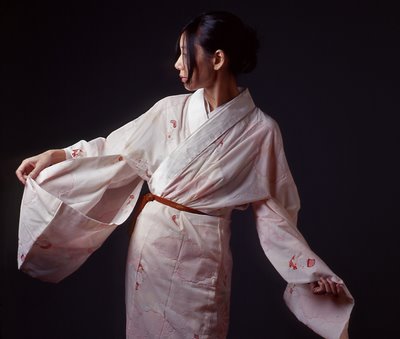
These are my privileged view.
Helen
more Helen
and even more Helen
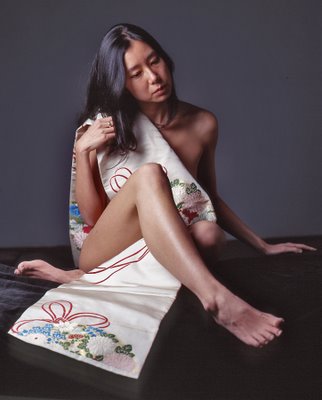

In 1959 one of my more sophisticated roomates, Dan Sherrod at St. Edward's High School in Austin Texas was into European sportscars (his father was the Aston Martin dealer in Midland, Texas), and esoteric stuff that was always in good taste. It was Dan who bought a record by a then almost unknown comedian Shelley Berman. The album was called Inside Shelly Berman.
Nobody should go through life without hearing his views on buttermilk (particularly what a glass of the stuff looks like after you have emptied it). Thanks to Shelley Berman I have never tried this particular lactic product.
Luckily Berman never spoke on yogurt or I would have never tried it. But it was not until I was 21 and in the Argentine Navy that I tried it. My secretary Edna Gahan came in one day with a jar of peach yogurt from a then renowned purveyor of milk products called La Vascongada. She was so obviously relishing it and she noticed that I had noticed. She offered me some but I refused telling her that I would never partake of rotten milk. She smiled and insisted. I have loved yogurt since.
At about that time I would be invited for high tea on weekends to my Uncle Freddy and Aunt Iris's. I never missed these even though I had to share the table with my boring first cousin (about my age) John Hayward. Aunt Iris made the best deviled ham on earth. I could stomach John's comments on his love of opera and in particular Wagner's operas as long as I had that deviled ham on the side.
By 1991 I had found that opera was not only not boring but fantastic. But I drew the line with Wagner. Then the Georgia Straight assigned me to photograph baritone Tom Fox who had come to town to sing Wagner's The Flying Dutchman.

I called up my friend James Delgado (right) who was then the Director of the Vancouver Maritime Museum. He told me he had a ship's wheel. I now had to find some sort of sunset backdrop for my concept shot of the Flying Dutchman. I went to Flashpoint and asked owner Berndt if he had such a thing. He looked at me and as if everybody asked for these particular backdrops every day he answered, "Do you want it with cumulus or stratus clouds?" I managed to stick the huge canvas roll in my wife's Audi 5000 (it was a big car) and took it to the Maritime Museum. Tom Fox looked the part and I was charmed.
Doug Tuck, then publicist for Vancouver Opera was so happy with my pictures that he offered to trade some for good tickets. Rosemary and I went with a bit of trepidation. We loved the Flying Dutchman.

Cousin John Hayward died in Toronto a few years after we saw that opera. I had a chance to visit him in Toronto. I found that he was urbane, interesting and certainly not boring. We had a lovely time together. John sent me a letter shortly after telling me how pleased he was that we had finally hit it off. My only regret is that I should have given him and that peach yogurt an earlier try. I would have been a better person for it.
Cousin John should I try buttermilk?
James Parkinson's Paralysis Agitans
Friday, September 12, 2008
Last night, while preparing my projected lecture (I talk and project jpgs from a CD through a lap top connected to a digital projector) I found a devastatingly disturbing portrait of great American photographer Margaret Bourke-White. The portrait was taken by Life Magazine photographer Alfred Eisenstaedt (1898 - 1995) in March 1959. Bourke-White who had taken the first cover for Life Magazine in September 1936 and flown in bombing mission (the first woman) in January 23, 1943 over Tunis she was previously and dashingly photographed by Eisenstaedt. The difference between the pictures made me think on not only how Bourke-White's career ended quite suddenly around 1953 when she learned she had Parkinson's but also how many of my friends (6) here in Vancouver have that terrible disease. I also know that Edward Weston, ultimately stopped taking photographs because of the crippling disease.
A couple of years back I had a student, Alan Jacques in my class at Focal Point. He had Parkinson's and he told me once, "I have my good days and my bad days. And today is a good one." This cheerful and talented photographer had mastered a special technique. He used wide angle lenses (they tend to minimize shake) and he opted for Nikon FM or FM-2s. He held these cameras firmly on his forhead and would use a wide stance with his legs and get close to his subjects. He shot beautiuful nudes in my nude photography class. A few months back I ran into Jacques whose photography business is going strong. I would suspect that this is one instance where digital photography has become a distinct asset.

I have heard of various photographers in the past who have been so in spite of being clinically blind. It seems to me that Parkinson's must then be the cruelest of all diseases to hit a photographer. Every morning when I wake up (more and more I do this) I check my hands.
In 1978 I took still photographs for the Vancouver CBC. One of my jobs was to photograph drama. The particular drama that took me to studio 40 one day was a show called Leo and Me. It featured Brent Carver (Leo) and a young boy (the me of Leo and Me) called Michael J. Fox. Years after I would go into my files and look at Leo and Me and go to throw them away. And then for who knows what reason I kept them. Here is one of the very young Michael J. Fox. He was a cheerful kind of kid and everybody on the set loved him. How were we to know?

In 2002, an investigation was launched into Leo and Me after an unusual cluster of Parkinson's disease cases was noted among former cast and crew members of the show. Fox and director Don Williams were among the four with the disease, along with a writer and a cameraman
Mr. Rampage, Mr. Pinhead And A Backseat Bombshell
Thursday, September 11, 2008

The story below is a story that needs the personal experience, wit and style of John Lekich. So I cede today's blog to him. Lekich has previously written two other guest blogs here and here.
Perhaps you think that punk rockers have no heart – that they are simply serial-puking cynics with safety pins stuck in all the wrong places. Thanks to a consummate gentleman known as Randy Rampage, I know better. His generous role in my sputtering love life all came back to me when Alex innocently asked: “Who was in Randy’s Cadillac with you anyway?”
I should explain that, many years ago, I had a fierce crush on a gorgeous blonde who has since attained an august reputation in local journalism circles. (For reasons of discretion, she will henceforth be referred to as Betty Bombshell.) My well-known adoration earned me little more than pitying looks from my fellow freelancers and the occasional medicinal glass of scotch from a sympathetic editor. All this changed when I made the acquaintance of Mr. Rampage who encouraged me to confront Betty with my feelings. When I explained that I was clearly out of Betty’s league, Randy related his own story about a seemingly unattainable blonde. “I worked up enough courage to ask her if she liked red wine,” he said. The gleam in his eye told the rest of the story, which he finished off with: “You just never know.”
I thought nothing more about it until – thanks to Alex’s vast social network - I found myself sharing a table at The Railway Club with Rampage, his fellow musician Zippy Pinhead, and none other than Betty herself. I recall stammering quite a bit. Mr. Rampage grasped the situation and – toward the end of lunch - asked Betty and me if we’d ever ridden in the backseat of a Cadillac. When we both responded negatively, he said: “Well, you’re going to now.” I recall that Mr. Pinhead also wanted to sit in the backseat, which had more space than my living room couch. Nevertheless, Mr. Rampage continually repeated that there was no room. When Zippy persisted, Randy barked: “You’re sitting in front!”
While I was unable to conquer my shyness, my proximity to the lovely Betty made for a cherished memory. After all these years, I continue to regard Mr. Rampage as alternative music’s answer to Miss Lonely Hearts. And – when I finally took his advice to become a little bolder with women - I discovered he was right. You just never know.
The Portuguese Bombshell In Red
Tuesday, September 09, 2008

When I photographed Ana in my studio around 8 years ago in my studio she wore my mother's red rebozo. This red rebozo was given to my mother in 1952 when she visited Mexico in preparation for us moving there from Buenos Aires. The rebozo is of very rough and raspy cotton and the vegetable dye is of the purest red I have ever seen. I store it in our wooden chest from Olinalá, Guerrero, Mexico. It has a sweet smell not unlike sandalwood but with more fruit in the scent. I have used it to photograph many beautiful women and I take it to my Focal Point photography classes and make my students use it as a prop in our life figure classes.
I do think that Ana, the Portuguese Bombshell's white skin has a particular affinity to the red of my mother's rebozo.
Rebecca, Che Guevara & My Pyrolytic Carbon Pipe
Monday, September 08, 2008

Today's blog really had its origins sometime in 1964 when I started smoking a pipe. My friend Robert Hijar was studying to get a fine arts degree at the University of the Americas in Mexico City and I admired his bohemian ways. While I was not a skirt chaser (I was much too shy for that sort of thing) I was jealous of Robert's many women. This attraction that women had for him had to do (I thought) because of his bohemian ways and that pipe. I began to smoke a pipe and wherever Robert and I went we always had a pipe attached to our mouth. I started with the usual aromatic blends like Cherry Blend and Sugar Barrel but settled on Edgeworth and in my later years on Three Nuns.
In 1967 I visited Robert in San Francisco. He was living in the Haight Ashbury area. He was surrounded by hippies and Robert still had many of the females after him. In spite of my pipe I was ignored by them. Robert convinced me to buy a new-fangled pipe made of pyrolytic carbon and hard rubber. This was a pipe you could wash in soap and water if you wanted to. I never did warm up to it as the smoke that entered my mouth seemed to be hotter that that of a briar pipe. While the pipe did not need to broken in it always tasted harsh.
I gave up the pipe and cigars sometime around 1992. My daughter Ale sent me an image from Lillooet that made me recall the pipe and a beret I had worn when I first came to Vancouver in 1975. I had thought that for me to stand out as a photographer in Vancouver I had to look different so I purchased a French beret like the one my Basque ancestors wore. My friend John Lekich asserts that not only did I wear a beret and smoke a pipe but I also wore a cape. He must be wrong as I have never owned one.

Ale in her email with the photograph of me with the beret and pipe told me it was her favourite self portrait of her father. I had to correct her and tell her that sometime in 1977 Rosemary had taken this photograph and I had printed it with an oval cutout to make it look old.
A few weeks ago Rebecca said she loved berets and that she wanted a red one. I knew I had this black one and gave it to her on Saturday. It was a hit and she kept going to the bathroom to look at herself in the mirror. Yesterday, Sunday when she arrived in the afternoon she said to me (while wearing the beret), "I am Che," and she brought up her right hand to her face and formed a fist.
I took some snaps of Rebecca with the beret in the TV room and then with two frames left we went out to the garden where there was more light. She insisted, "Who shaves the barber? I have to take your picture." I took one frame and then she took the next. Here you see the results.

I wonder if I should have done what I did in the end. Rebecca seemed to have shaky knowledge on who Che Guevara was so I told her, "Let me show you my favourite photograph of him." And I did. I showed her the picture of Che dead on that slab taken in the laundry area in Vallegrande, Bolivia. She looked at it and was repelled. Previously to that she wanted me to photograph her with a pipe. She put the pipe in her mouth and almost spit it out, "It tastes of tobacco!" she shouted. At least I got that one right.
The Women - My Women - A Stray Man
Sunday, September 07, 2008

There is no way that George Cukor's wonderful 1938 film The Women can possibly work in its 2008 incarnation. I won't bother to see it. How could anybody top this cast: Norma Shearer, Joan Crawford, Rosalind Russell, Paulette Goddard, Joan Fontaine and the unflappable, scary but ultimately kind Marjorie Main?
I recall that no men are ever seen and the only walk on male is a dog.
I feel the same about my very own women. Yesterday was a perfect day with all the women of my life present and accounted for and all at home.
Hilary's husband, Bruce Stewart has a new schedule which means we no longer get Lauren and Rebecca on Saturdays but on Sundays. This will probably mean no Sunday night film as the girls will have to go home early because of Monday school. We will also miss the lazy Saturday afternoon dinners with Hilary arriving from work. Since Bruce was always working I was the only man around besides Rosemary's male cat Toby. My exclusive isolation might be over.

There is one benefit to the change if we can somehow convince the Stewart family that Saturday evening dinners at our place will be welcomed. What made our family dinner even better yesterday was the presence of my other daughter Ale who was in Vancouver for the weekend. Our family was complete and I took advantage and took some pictures of the girls and then one with Bruce.
Alas even though I had thought the film in my camera was ISO 400 and I exposed it as such I was shocked to find out that the film in question was Plus-X ISO 100. I processed the film at double the processing time (from almost 5 to almost 11 minutes). While the negatives had a higher contrast they are not bad.
The menu last night was:
1. Barbecued pork loin (Stubb's Pork Marinade from Austin, Texas) served with Keen's mustard.
2. Cucumber salad.
3. Sliced tomatoes brought by Ale from her Lillooet garden.
4. Fresh corn on the cob
5. Mashed potatoes mixed with mashed carrots with lots of butter and cream.
We accompanied it all with my special iced tea (made with Russian Caravan tea) and Rosemary made a Pavlova with fresh peaches, strawberries and cream. Hilary insisted in adding Argentine dulce de leche. An almost perfect evening made perfect when I salvaged the grossly underexposed film.
Recipe for Iced Tea
1. 14 heaping teaspoons of loose Russian Caravan tea.
2. 6 cloves
3. 1 large tablespoon cinnamon
4. 1 teaspoon nutmeg
5. A large handufl of fresh mint
Pour just boiling water into large teapot (2 litre) and allow to steep for 10 minutes. Strain into large pot. Boil more water and re-fill teapot without adding any more ingredients. Steep for 10 minutes.
To the pot add the juice of 8 to 9 lemons and 8 oranges (strained). Sweeten to taste. The smoky Russian Caravan cuts the sweetness so more sugar might be needed. The secret to this tea is to score the pressed lemons with a knife and to throw them into the mixture for at least half a day in the fridge. When your guests arrive pour tea into a large pitcher and add ice to dilute the strong mixture to taste.

My Privileged View
Saturday, September 06, 2008

I have been through this avenue before but not in colour. I have written about Malcolm Parry's privileged view. He maintains that the masses look up and the few, privileged, look down. Everybody looks up at tall buildings. The very few who can, get on the roof and look down. It helps that Mr. Parry is very tall and he is able to shoot down with his camera. He is renowned in how his extra height allows him to capture gossip cleavage like no other in his profession.

I have my own definition of the privileged view which has nothing to do with height. A couple of years ago the Georgia Straight asked me to photograph three rock bands inside Bradley's (a downtown strip joint). Don't ask me why it was that the Straight wanted this. But I took it seriously. Everybody can see a stripper on stage. But few get a glimpse into what happens in the dressing room. I had to go through a few Italian named bikers before I got a green light for the photograph. This was and is indeed a privileged view.

When Helen knocked on the door of my studio, I opened to find her dressed in her mother's kimono. She could barely walk everything was so tightly put on. She then slowly removed layer by layer for my camera. It was slow enough that I was able to do it in colour transparency as seen here, in b+w and in b+w infrared.

These are my privileged view.
Helen
more Helen
and even more Helen

Friday, September 05, 2008

Note: Blogger limits the size of a picture on its original format. But if you left click on this image it will get bigger and more so if you click again.
Last week Rosemary, girls (Lauren and Rebecca) and I decided to see what the new UBC Canopy walk was like. The folks at the UBC Botanical Garden and Centre for Plant Research (yes that's its official name) decided that the best kept secret in our city (a world class botanical garden) needed to be better known so that more visitors would turn the turnstiles. That is the goal of the canopy walk. A path up in the trees, all in lightweight aluminum and suspended by the trees and reinforced from the bottom in a way that all the metal allows the trees to grow without restraint, soars and for some who may notice, sway and swing a bit. If you are afraid of heights stay away. If you like excitement don't.
Rosemary felt shaky and Lauren was cautious for a few minutes. But as soon as she got her sky legs she was walking on the narrow pathways (looking down was especially thrilling) full of confidence as some of the rest of us.
But the best feature of this walkway is that it pulls you into the garden and once you are in it your eyes will open to all the wonders there.
Rebecca and I walked (on the ground now) and we touched and felt the leaves of the rhododendrons of the garden (one of the biggest in North America). Most had indumentum a felty undergrowth on the leaves, sometimes white or red or cinnamon coloured. This indumentum reminded us of the soft inside of a cat's ears. And to Rebecca's delight we found rhododendrons that not only had indumentum but tomentum (the indumentum equivalent on the top of the leaves). One in particular amazed us as it felt like stroaking a snake's skin.
the Canopy Walkway.
In his 1979 book Arabia, Jonathan Raban describes how he eventually was able to, "Just be sitting at table among mosquitoes with glasses of Stella beer..." with his fellow travel writer of note, Jan Morris when both happened to be in Cairo. He tells it like this:
As James Morris, she had lived in Cairo on a houseboat in the 1950s. James Morris had been the correspondent in the Middle East for the London Times, and before that he had worked for a news bureau. Jan Morris, commissioned by Rolling Stone Magazine, was revisiting Cairo for the first time since she had changed gender, and she was nervous about what Jan might see in James's city."
Or as Morris herself told Raban, "I'm so frightened of going back to places and finding that I liked them better as I was than I do as I am."
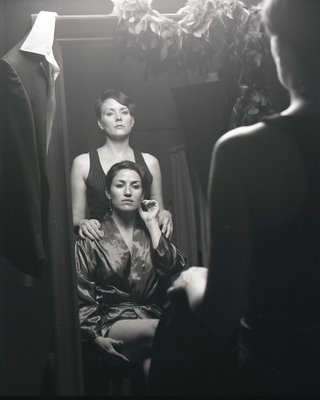
Like most men I have been sexually confused many times. I remember the first time. I was around 7 years old and the day was such a shock to me that I even remember I was in a colectivo (a Buenos Aires bus) on the fashionable then (and now) Avenida Esmeralda. A woman got on with a strange little person. He or she was wearing a dress but he or she had a shaved head. Until then I thought that boys and men had short hair and wore pants (short or long but preferably short) and girls and women wore skirts or dresses and had long hair. I was confused. Was she a boy or was he a girl?
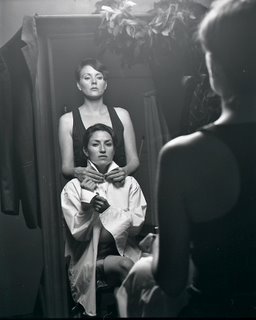
My second moment of sexual confusion happened when I was around 8. It was a Buenos Aires carnaval and people dressed up and sprayed each other with pomos which were large toothpaste type tubes made of metal and full of perfumed water. I had gone to see a western with my grandmother on movie theatre row on Avenida Lavalle.

We were in the subte (the Buenos Aires underground) on our way to Retiro train station to take me home. From my vantage point I could see the end of the other subway car and there was a woman's bare back facing me. She had long hair but something was wrong. Her back did not look like a woman's. What could she possibly be? I was confused.
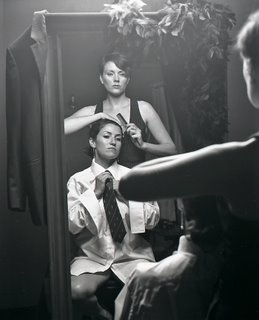
Not long after an American girl came to my house to play and asked me, "Do you want to see it?" I was much too naive to figure out what exactly I was going to see. When I saw it, "it" did not resemble at all what my precocious (so I thought friend Mario had told me that girls had up front. I was confused again.
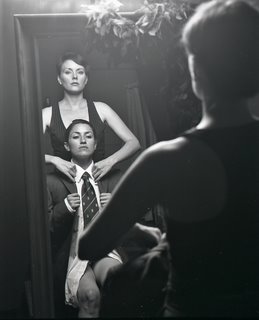
In more recent times I have been repelled by the usual macho reaction to seeing two women together. These are usually photographs of gorgeous women with red fingernails and fantastic bodies interacting on divans. It ocurred to me that there are better and more interesting ways of showing these most feminine activities. A film, Bitter Moon directed by Roman Polanski comes to mind every time I think of this. In this film both Peter Coyote and Hugh Grant (both playing idiots) are left in the lurch in the end by the two women of their life, Kristin Scott Thomas and Emmanuelle Seigner. When these two abandon their men and proceed to dance with each other I was wonderfully shocked.
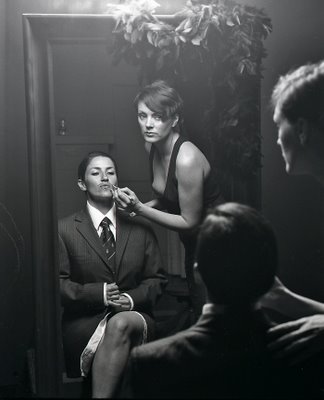
I had something of the sort in mind when I placed Ms. Hernandez and Cordelia in front of my Ikea mirror.
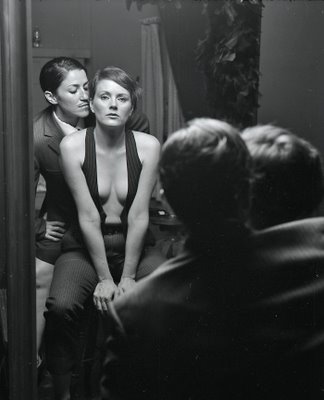
In one of the many books by Jan Morris that I have read I remember a wonderful sentence that she wrote upon seeing a large portrait of British Lord Admiral John Arbuthnot Fisher. I recall that Morris wrote something like, "The man that I was, admired the man that is in front of me and the woman that I am, could possibly have loved the man that he was."
She was never confused. I am sometimes.
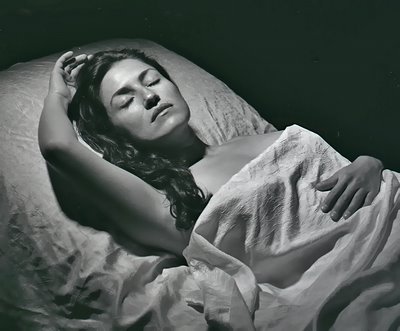
While I have written about the notable Mexican actress Dolores del Río here (see previous blog) I must stress that the most famous Mexican actress of them all was María Felix (April 8, 1914 - April 8, 2002). She is not well known abroad (as in North America) because she never made a film in Hollywood. She lost to Jennifer Jones the part that was allegedly written for her in King Vidor's 1946 film Duel In The Sun because of prior commitments.
Mexicans and the Spaniards share lots of tradition and history. They also share statements that are rarely contested simply because the rest of the world does not give these two countries any weight. The Spaniards believe that the most perfect and beautiful painting in the world is Diego Velázquez's Las Meninas. I agree. I saw it at the Prado Museum many years ago with my wife and daughters. We all remember its luminous magic.
With equal passion Mexicans assert that María Felix was the most beautiful woman in the world when she was alive. I would agree, too. She had a throaty voice and in a world of macho men she could make men cower in fear with just the raising of one of her dramatic eyebrows. It was said that she had an affair with the married and powerful Mexican president Miguel Alemán. It was said that not only did she have an affair with Diego Rivera but with his wife, Frida Kahlo, too. I saw many of her films as a boy in the 50s and by the beginning of the 60s there were rumours that "La Dueña" would spend a month in Paris asleep. The French had discovered (so the story went) a method by which after a month's deep sleep, La Felix would wake up rejuvinated with skin like the skin she had had when 20. I believed the story. That somehow this Mexican Helen could be affected by the ravages of time was a possibility we refused to consider.

When Ms Hernandez was lying in my studio's psychiatric couch (I purchased it many years ago from a retiring shrink for $100 which included the delivery to my studio) a couple of days ago for this installment of my Mexican nostalgia I thought she was perfect.
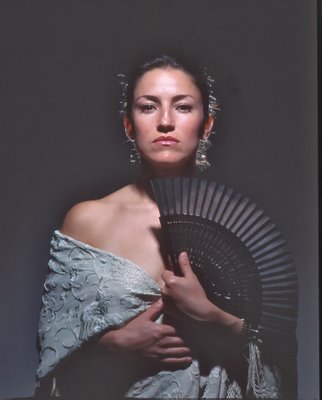
I prefer women with a past. They're always so demmed amusing to talk to.
Lady Windermere's Fan - Oscar Wilde
In 1959 while living in Mexico City my mother took me to the theatre to see an adaptation into Spanish of Oscar Wilde's play Lady Windermere's Fan. I remember little except the voice of Dolores del Río who played Lady Windermere. I was electrified by it and by the noise of the opening and closing of her fan with the flip of the wrist. I had never seen her live but had admired her in her films, both Mexican and my favourite of hers in English, John Ford's The Fugitive.
When I posed Ms. Hernandez this morning wearing my grandmother's light green Spanish mantilla and her fan I could almost hear that voice again.
The other haunting image of The Fugitive is played by that other noted Mexican actor, Pedro Armendariz. He was a handsome man with a beautiful face and voice. As a Police Lieutenant he is in search of our whisky priest, Henry Fonda. In spite of it all Armendáriz was able to distill some humanity into what was supposed to be the role of a fanatical unbeliever.
Those who may be regulars of this blog should not expect soon any attempts on my part to pencil in a moustache on Ms Hernandez to pursue my nostalgia for Pedro Armendáriz.
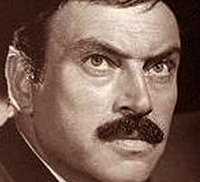

Today Rosemary almost turned on the furnace. She felt cold. Many of my multipetalled English Roses have buds that probably will not open if the cooler weather persists. But some of my roses surprised me, opening up and perfuming the garden as an almost last gasp before the smell of decaying falling leaves of the season that is upon us takes over.
Dichroa febrifuga is a half-hardy shrub that is related to hydrangeas. We have it in a pot under the cherry tree. We are going to take our chances this year and we are going to plant it in the ground. The blue flowers are followed by metallic blue berries. It is native to Nepal eastwards to southern China and into south-east Asia. The specific epithet febrifuga is in reference to the use of the plant as a febrifuge, acting to reduce fever.
 There are two unlikely companions here made so by scanning them together. Rosa 'Ferdinand Pichard' like most roses prefers full sun while Hydrangea macrophylla 'Ayesha' grows best in partial shade. Notice the little florets of the hydrangea that resemble tea saucers. This is the only hydrangea that looks like this.
There are two unlikely companions here made so by scanning them together. Rosa 'Ferdinand Pichard' like most roses prefers full sun while Hydrangea macrophylla 'Ayesha' grows best in partial shade. Notice the little florets of the hydrangea that resemble tea saucers. This is the only hydrangea that looks like this.


Not far from the dichroa I have a few smaller hostas. One of my favourites is Hosta kikutti var. leuconata.. The leaves are narrow and elegant and have startling white undersides. Before the flowers open the scape looks like an exotic bird. This hosta blooms late in the season and its flowers are lovely.

Note: Blogger limits the size of a picture on its original format. But if you left click on this image it will get bigger and more so if you click again.
Last week Rosemary, girls (Lauren and Rebecca) and I decided to see what the new UBC Canopy walk was like. The folks at the UBC Botanical Garden and Centre for Plant Research (yes that's its official name) decided that the best kept secret in our city (a world class botanical garden) needed to be better known so that more visitors would turn the turnstiles. That is the goal of the canopy walk. A path up in the trees, all in lightweight aluminum and suspended by the trees and reinforced from the bottom in a way that all the metal allows the trees to grow without restraint, soars and for some who may notice, sway and swing a bit. If you are afraid of heights stay away. If you like excitement don't.
Rosemary felt shaky and Lauren was cautious for a few minutes. But as soon as she got her sky legs she was walking on the narrow pathways (looking down was especially thrilling) full of confidence as some of the rest of us.
But the best feature of this walkway is that it pulls you into the garden and once you are in it your eyes will open to all the wonders there.
Rebecca and I walked (on the ground now) and we touched and felt the leaves of the rhododendrons of the garden (one of the biggest in North America). Most had indumentum a felty undergrowth on the leaves, sometimes white or red or cinnamon coloured. This indumentum reminded us of the soft inside of a cat's ears. And to Rebecca's delight we found rhododendrons that not only had indumentum but tomentum (the indumentum equivalent on the top of the leaves). One in particular amazed us as it felt like stroaking a snake's skin.
the Canopy Walkway.
Ms. Hernandez, Cordelia & Jan Morris
Thursday, September 04, 2008
In his 1979 book Arabia, Jonathan Raban describes how he eventually was able to, "Just be sitting at table among mosquitoes with glasses of Stella beer..." with his fellow travel writer of note, Jan Morris when both happened to be in Cairo. He tells it like this:
As James Morris, she had lived in Cairo on a houseboat in the 1950s. James Morris had been the correspondent in the Middle East for the London Times, and before that he had worked for a news bureau. Jan Morris, commissioned by Rolling Stone Magazine, was revisiting Cairo for the first time since she had changed gender, and she was nervous about what Jan might see in James's city."
Or as Morris herself told Raban, "I'm so frightened of going back to places and finding that I liked them better as I was than I do as I am."

Like most men I have been sexually confused many times. I remember the first time. I was around 7 years old and the day was such a shock to me that I even remember I was in a colectivo (a Buenos Aires bus) on the fashionable then (and now) Avenida Esmeralda. A woman got on with a strange little person. He or she was wearing a dress but he or she had a shaved head. Until then I thought that boys and men had short hair and wore pants (short or long but preferably short) and girls and women wore skirts or dresses and had long hair. I was confused. Was she a boy or was he a girl?

My second moment of sexual confusion happened when I was around 8. It was a Buenos Aires carnaval and people dressed up and sprayed each other with pomos which were large toothpaste type tubes made of metal and full of perfumed water. I had gone to see a western with my grandmother on movie theatre row on Avenida Lavalle.

We were in the subte (the Buenos Aires underground) on our way to Retiro train station to take me home. From my vantage point I could see the end of the other subway car and there was a woman's bare back facing me. She had long hair but something was wrong. Her back did not look like a woman's. What could she possibly be? I was confused.

Not long after an American girl came to my house to play and asked me, "Do you want to see it?" I was much too naive to figure out what exactly I was going to see. When I saw it, "it" did not resemble at all what my precocious (so I thought friend Mario had told me that girls had up front. I was confused again.

In more recent times I have been repelled by the usual macho reaction to seeing two women together. These are usually photographs of gorgeous women with red fingernails and fantastic bodies interacting on divans. It ocurred to me that there are better and more interesting ways of showing these most feminine activities. A film, Bitter Moon directed by Roman Polanski comes to mind every time I think of this. In this film both Peter Coyote and Hugh Grant (both playing idiots) are left in the lurch in the end by the two women of their life, Kristin Scott Thomas and Emmanuelle Seigner. When these two abandon their men and proceed to dance with each other I was wonderfully shocked.

I had something of the sort in mind when I placed Ms. Hernandez and Cordelia in front of my Ikea mirror.

In one of the many books by Jan Morris that I have read I remember a wonderful sentence that she wrote upon seeing a large portrait of British Lord Admiral John Arbuthnot Fisher. I recall that Morris wrote something like, "The man that I was, admired the man that is in front of me and the woman that I am, could possibly have loved the man that he was."
She was never confused. I am sometimes.
María Felix Sleeps In Paris
Wednesday, September 03, 2008

While I have written about the notable Mexican actress Dolores del Río here (see previous blog) I must stress that the most famous Mexican actress of them all was María Felix (April 8, 1914 - April 8, 2002). She is not well known abroad (as in North America) because she never made a film in Hollywood. She lost to Jennifer Jones the part that was allegedly written for her in King Vidor's 1946 film Duel In The Sun because of prior commitments.
Mexicans and the Spaniards share lots of tradition and history. They also share statements that are rarely contested simply because the rest of the world does not give these two countries any weight. The Spaniards believe that the most perfect and beautiful painting in the world is Diego Velázquez's Las Meninas. I agree. I saw it at the Prado Museum many years ago with my wife and daughters. We all remember its luminous magic.
With equal passion Mexicans assert that María Felix was the most beautiful woman in the world when she was alive. I would agree, too. She had a throaty voice and in a world of macho men she could make men cower in fear with just the raising of one of her dramatic eyebrows. It was said that she had an affair with the married and powerful Mexican president Miguel Alemán. It was said that not only did she have an affair with Diego Rivera but with his wife, Frida Kahlo, too. I saw many of her films as a boy in the 50s and by the beginning of the 60s there were rumours that "La Dueña" would spend a month in Paris asleep. The French had discovered (so the story went) a method by which after a month's deep sleep, La Felix would wake up rejuvinated with skin like the skin she had had when 20. I believed the story. That somehow this Mexican Helen could be affected by the ravages of time was a possibility we refused to consider.

When Ms Hernandez was lying in my studio's psychiatric couch (I purchased it many years ago from a retiring shrink for $100 which included the delivery to my studio) a couple of days ago for this installment of my Mexican nostalgia I thought she was perfect.
Lady Windermere's Fan
Tuesday, September 02, 2008

I prefer women with a past. They're always so demmed amusing to talk to.
Lady Windermere's Fan - Oscar Wilde
In 1959 while living in Mexico City my mother took me to the theatre to see an adaptation into Spanish of Oscar Wilde's play Lady Windermere's Fan. I remember little except the voice of Dolores del Río who played Lady Windermere. I was electrified by it and by the noise of the opening and closing of her fan with the flip of the wrist. I had never seen her live but had admired her in her films, both Mexican and my favourite of hers in English, John Ford's The Fugitive.
When I posed Ms. Hernandez this morning wearing my grandmother's light green Spanish mantilla and her fan I could almost hear that voice again.
The other haunting image of The Fugitive is played by that other noted Mexican actor, Pedro Armendariz. He was a handsome man with a beautiful face and voice. As a Police Lieutenant he is in search of our whisky priest, Henry Fonda. In spite of it all Armendáriz was able to distill some humanity into what was supposed to be the role of a fanatical unbeliever.
Those who may be regulars of this blog should not expect soon any attempts on my part to pencil in a moustache on Ms Hernandez to pursue my nostalgia for Pedro Armendáriz.

Dichroa febrifuga & Friends
Monday, September 01, 2008

Today Rosemary almost turned on the furnace. She felt cold. Many of my multipetalled English Roses have buds that probably will not open if the cooler weather persists. But some of my roses surprised me, opening up and perfuming the garden as an almost last gasp before the smell of decaying falling leaves of the season that is upon us takes over.
Dichroa febrifuga is a half-hardy shrub that is related to hydrangeas. We have it in a pot under the cherry tree. We are going to take our chances this year and we are going to plant it in the ground. The blue flowers are followed by metallic blue berries. It is native to Nepal eastwards to southern China and into south-east Asia. The specific epithet febrifuga is in reference to the use of the plant as a febrifuge, acting to reduce fever.
 There are two unlikely companions here made so by scanning them together. Rosa 'Ferdinand Pichard' like most roses prefers full sun while Hydrangea macrophylla 'Ayesha' grows best in partial shade. Notice the little florets of the hydrangea that resemble tea saucers. This is the only hydrangea that looks like this.
There are two unlikely companions here made so by scanning them together. Rosa 'Ferdinand Pichard' like most roses prefers full sun while Hydrangea macrophylla 'Ayesha' grows best in partial shade. Notice the little florets of the hydrangea that resemble tea saucers. This is the only hydrangea that looks like this.
Not far from the dichroa I have a few smaller hostas. One of my favourites is Hosta kikutti var. leuconata.. The leaves are narrow and elegant and have startling white undersides. Before the flowers open the scape looks like an exotic bird. This hosta blooms late in the season and its flowers are lovely.






